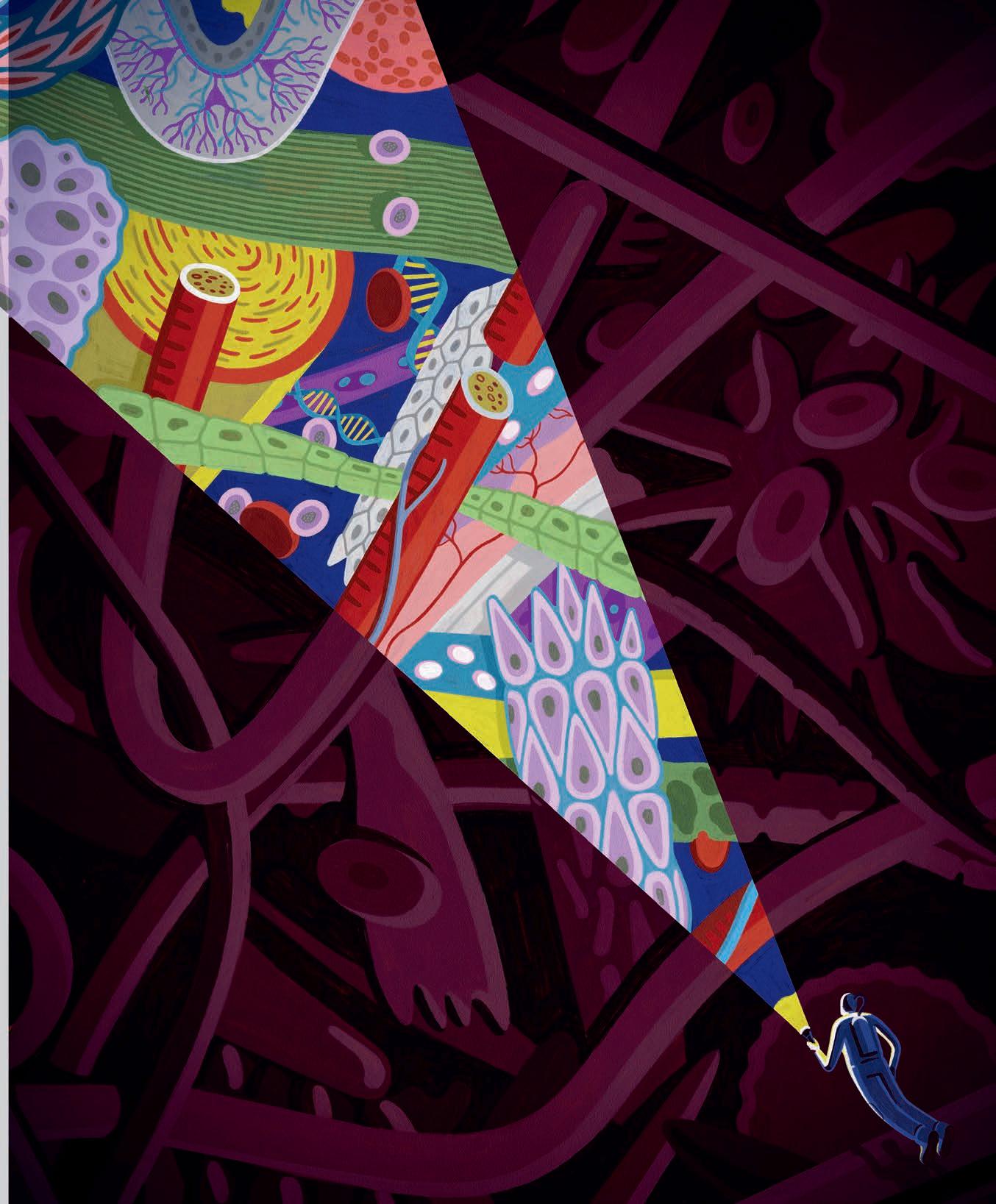

Engineering the Future of Health
to conduct interdisciplinary, fundamental and translational research in the synthesis of novel biomolecules and new polymers to sense, understand and direct biological function, and to design new therapeutics.
Penn Engineers have the advantage of being immersed in an exciting, interdisciplinary culture on a campus where collaborations across schools are the norm rather than an exception. The Penn ecosystem includes a rapidly growing startup culture with a very efficient lab-to-market pipeline.
Kumar Nemirovsky Family DeanWhether designing and prototyping novel medical devices, mining massive amounts of data and electronic records for information, developing precision diagnostic technologies, or discovering new biologics, engineering is an intrinsic part of healthcare in ways both seen and unseen.
Creating a future healthcare system that is innovative, sustainable and equitable will not happen without engineers, and Penn Engineering, in partnership with Penn Medicine, is uniquely positioned to be a leader in addressing this challenge.
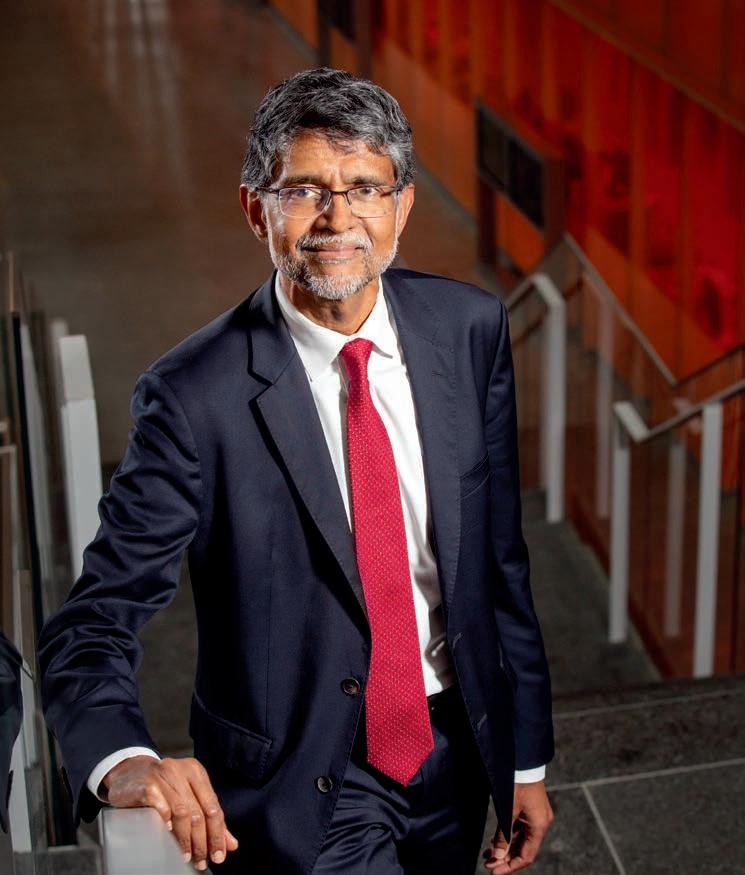
In addition to leading-edge projects in engineering and human health already underway in the School, Penn recently made a $100 million investment in our School’s new Center for Precision Engineering for Health (CPE4H), which will enable Penn Engineers and their collaborators
If you turn to page 12 in this newly redesigned issue of Penn Engineering, you will get a chance to explore a sampling of the exciting projects that Penn Engineers are conducting in our efforts to address the global challenge of healthcare.
In addition, I hope that this new format gives our readers the opportunity to learn about even more of the exciting advances that Penn Engineers are making, the questions we are trying to answer, the startups that have made their way from idea to reality, the contributions of our postdoctoral fellows, the innovative mindset of our students, and the incredible spaces and resources available to us here at Penn.
As you take in this issue, you can now expe rience what I do when I walk through the Penn Engineering complex: being awed and humbled by the breadth of intellect, innovation and imagi nation across all of our departments and centers as we work together to engineer the future.


THE BIG PICTURE
Music in the Time of COVID H
ow can musicians gather together for live performances when the usual methods employed to combat the spread of respiratory viruses like COVID-19 (masks, plexiglass dividers and of course… no gath ering) cannot be used?
In 2020, The Philadelphia Orchestra sought the expertise of Paulo Arratia, Professor in Mechanical Engineering and Applied Mechanics ( MEAM ), and Douglas Jerolmack, Professor in Earth and Environmental Science and MEAM, to answer this question.
The research team worked with musicians wielding brass and woodwind instruments to study how aerosols flowing out of instruments moved through the air, operating a humidifier that emitted water vapor droplets that would capture the air flow leaving the instrument. Using a laser beam that would shine through the cloud created by the humidifier, they could highlight the aerosol particles and allow them to be captured by a highspeed camera; they also measured the aerosol concentration emitted from the instruments by using a particle counter.
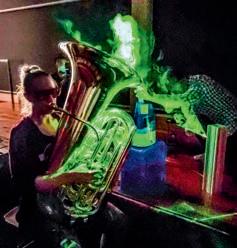
Together, Arratia and Jerolmack discovered that musicians produce aerosols that dissipate within about six feet, allowing The Philadelphia Orchestra to reconfigure their layout and resume performances in the summer of 2020.

In order to visualize and track aerosols produced by musicians, the researchers operated a humidifier that emitted water vapor droplets at the bell end of the instru ments. The team then used a laser beam to light up the aerosol particles in the vapor, allowing them to be captured by a high-speed camera and particle counter.
The team’s work was recently published in the journal Physics of Fluids , providing new insight for both researchers and other musi cians to more confidently gather and perform.
BREAKTHROUGHS
Micro Manipulators
BY Melissa PappasControlling microscopic processes is inherently challenging. The everyday tools we use to manipulate matter on the macroscale can’t simply be shrunk down to the size of a cell, and even if they could, the physical forces they rely on work differently when their targets are measured in nanometers. But while it’s no easy feat, attaining this type of control would pay enormous dividends: from transporting drugs to tumors for precise therapies, to making func tional materials out of microscopic building blocks, to enabling new kinds of displays and sensors.
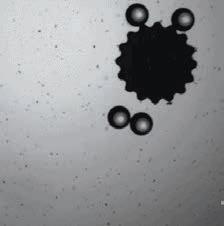
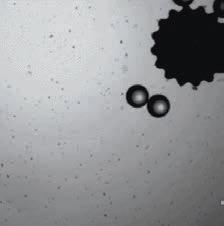
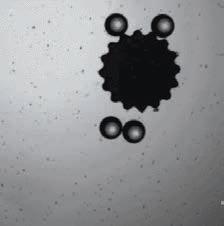
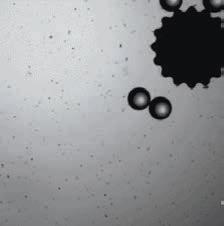
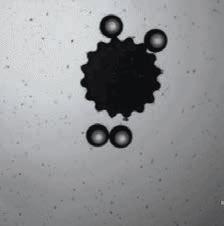
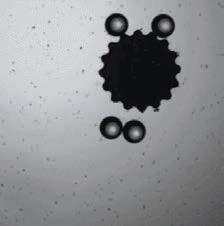
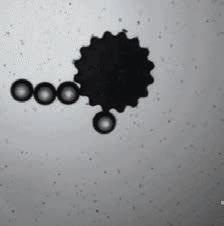
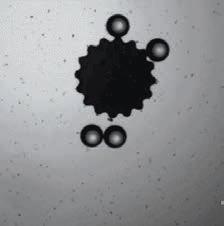
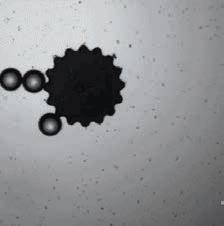
One approach for controlling these types of processes is via microrobots.
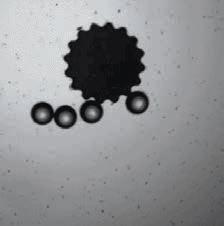
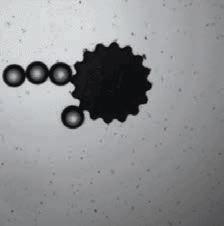
We typically think of robots as computer ized machines like those on assembly lines or in warehouses, programmed to move cargo and to build complex structures like automobiles and
cellphones. However, programming a device smaller than a microchip presents another kind of challenge. Robots on this scale need to be designed in a completely different way than their bigger counterparts.
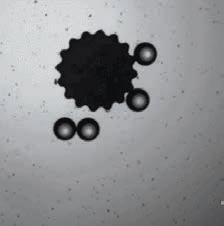
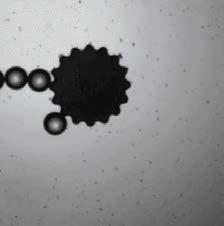
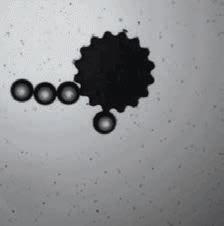
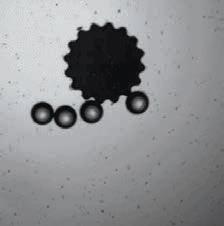
Since they’re too small for their own onboard computers, microrobots’ movements are controlled by an external magnetic force. And to manipulate equally small cargo, they need to take advantage of the different physical and chemical laws that rule the microscale.
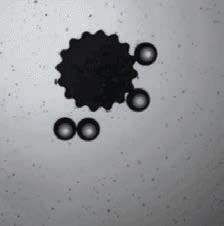
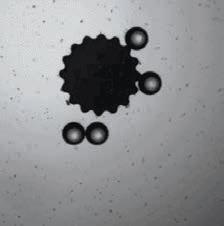
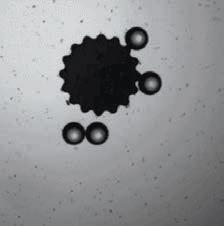
At those sizes, every object is greatly influ enced by the molecules surrounding it. Whether they are surrounded by gas, like the ambient atmosphere, or dispersed in a liquid, micro robots must be designed to exploit this influence, a concept known as “physical intelligence.”
Kathleen Stebe, Richer & Elizabeth Goodwin Professor in Chemical and Biomolecular Engineering and Mechanical Engineering and Applied Mechanics, Tianyi Yao and Qi Xing Zhang, graduate students in her lab, and collabo rators at the University of Ljubljana, Slovenia, are establishing some of the fundamentals of physi cally intelligent microrobots, publishing a pair of groundbreaking papers earlier this year.
Their studies investigated magnetic micro robots swimming through nematic liquid crystals ( NLC s), the fluid that makes up each pixel in a
liquid crystal display. Colloidal systems like these, where one material is dispersed through another, can give even the simplest microrobots a way of doing work; rather than arm-like mechanical grip pers you would find on an assembly line, they can extend “force fields” of elastic energy by altering the arrangement of molecules around them.
“Nematic liquid crystals exist as a special phase, a structured fluid that is neither liquid nor solid,” says Stebe. “NLCs consist of elongated molecules that self-align in a configuration that requires the least amount of energy. Think of shaking a pan of rice; the grains all align. When you disturb the nematic alignment by introducing microrobots or colloidal cargo, you get really interesting dynamics that you don’t see in water, for example.”

In one study, Stebe and her colleagues deployed X-shaped microrobots, each roughly a twentieth of a millimeter across, and showed how they could pick up and move spherical particles in complicated ways. Though their four stumpy arms can’t grab this cargo on their own, their specially designed shape disrupts the surrounding NLCs in such a way that the particles are attracted to the microrobot’s edges.
MICROROBOTS
IN YOUR MOUTH
Applications for tiny robots are diverse, requiring the design of each robotic system to be as unique as the problem it aims to solve. At the Center for Innovation and Precision Dentistry (CiPD), directors Stebe and Hyun (Michel) Koo, Professor in Penn Dental Medicine, look to microrobots to help clean, sample and diagnose plaque buildup and infections in the mouth. Together with Edward Steager, senior research inves tigator at Penn Engineering, they designed physically intel ligent, magnetically controlled iron oxide nanoparticles that can move through the
The team also demonstrated more advanced maneuvers, flicking particles away with a twist, or using the geometry of stationary structures in the environment to deposit them in specific locations.
The team’s other study answered even more fundamental questions about the microrobots’ swimming and gripping abilities. There, they used a robot with an even simpler shape a flat disk and a simpler form of magnetic control. By rotating the magnetic field back and forth, they saw that one side of the disk would lift, creating a disruption in the liquid crystal pattern under neath it. This created an energy gradient that the microrobot could follow, propelling itself forward without needing to be dragged along by the external magnetic field.
Stebe and her team are now able to imagine real-world applications for this technology in the optical device industry as well as in many other fields.
“Together with dedicated colleagues and graduate students, we have been working hard on this technology and are excited to see years of work come to fruition,” she says. “We are now standing on the edge of real applications and ready to explore.”
complex anatomy of the root canal or act as a swarm to brush and floss your teeth. Root canal operations are common, but not highly efficient or very comfortable. Koo and Steager developed microrobots embedded with iron oxide nanoparticles con trolled by an external magnet that can move through the root canal. Along their journey, these microrobots remove plaque, take samples and deliver targeted therapies. This technology removes the need to drill through the tooth to reach the infected area as is done in traditional root canal procedures.
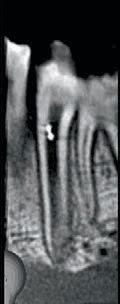
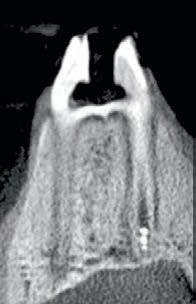
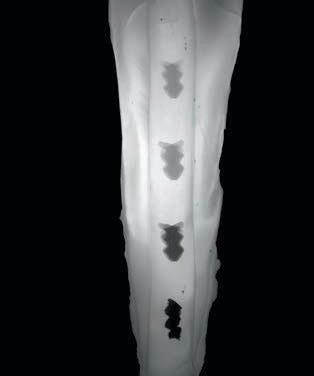
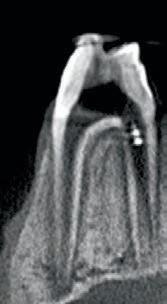
But before a patient needs a root canal procedure, microro bots can aid them in everyday dental hygiene.
The same nanoparticles can form a swarm in the shape of bristles, like a toothbrush, or elongated strings, like floss, to mechanically scrub and sweep plaque from teeth. The particles also chemically remove plaque through a catalytic reaction triggering a production of antimicrobials, providing multiple forms of attack on the biofilm in the patient’s mouth.
QUADRUPLING MICROBATTERY ENERGY DENSITY
James Pikul, Assistant Professor in Mechanical Engineering and Applied Mechanics, and his team have found a new way to build and package microbatteries that maximizes energy density even at the smallest sizes.
Mobile electronics like robots and wearables are pushing batteries to be smaller and lighter, properties at odds with the need to make them last longer and be more durable. Working against this need is the fact that energy density gets substantially harder to improve upon as a battery gets smaller, partially because larger portions of a battery’s footprint must be devoted to protective packaging.
Confronted with this challenge, Pikul and his group developed a new kind of current collector and cathode that together act as both an electron conductor and the packaging that prevents water and oxygen from getting into the battery. This increases the fraction of materials that store energy and reduces the need for non-conductive packaging that normally protects a battery’s sensitive internal chemicals.
INSIDE ENGINEERING
BIOENGINEERING
actual-ish size
Encrypted Peptides as Antibiotics César de la Fuente, Presidential Assistant Professor, and his research group have used an algorithm to pinpoint specific sequences in our protein code that reveal encrypted peptides with antimicrobial properties that could act as naturally occurring antibiotics within our own bodies.
CHEMICAL AND BIOMOLECULAR ENGINEERING
Shrinking Separation’s Carbon Footprint

In the lab of Chinedum Osuji, Eduardo D. Glandt Presidential Professor and Chair, researchers are decreasing the energy needed for chemical separation by leveraging energy-efficient organic separations that use nanofiltration and self-assembling membranes.
COMPUTER AND INFORMATION SCIENCE
Unmasking Social Bots
Using state-of-the-art machine learning and natural language processing techniques, Lyle Ungar, Professor, has collaborated to show that social media bots’ similarity to one another reveals their artificial nature, suggesting a new detection strategy.
Weighing about as much as two grains of rice but with the energy density of a much larger, heavier battery, this packaging-free design could enable a host of otherwise impossible electronics.
TV NEWS DRIVES DIVISION
contrary to what many believe, social media and other online outlets are not the main source of news echo chambers and their resulting divisive ness in the United States.
Research by Duncan Watts, Stevens Univer sity Professor in Computer and Information Science with appointments in Penn’s Annen berg School for Communication and in Wharton, and his collaborators has shown that just 4% of Americans are in what can be called echo cham bers online, contrasted with 17% of Americans who are in such echo chambers with their TV news consumption.
The team also found that just 21% of Americans are responsible for 60% of news consumption, meaning that individuals in TV news echo cham bers watch more news than those who are not, and that they are more likely to stick around as viewers: A partisan TV news diet has a 25% chance of lasting six months; online, it has only a 5% chance of lasting that amount of time.
Additionally, Watts and his group show that millions of TV viewers only watch content from
ELECTRICAL AND SYSTEMS ENGINEERING
2 Billion Images Per Second
Firooz Aflatouni, Associate Professor, and his lab have created the first scalable chip that classifies and recognizes images almost instantaneously, enabling more sophisticated image classification, such as identifying moving objects, 3D object identification, or classification of microscopic cells in the body.
a single source, such as CNN , MSNBC or FOX . This means that if information from one of those sources is misleading or problematic, the effects can be far worse among TV audiences than among people who consume that channel’s content via social media news algorithms, since online audi ences tend to have more varied news diets to balance out their consumption.
Through their work, Watts and his collabora tors hope to call more attention to the issue of TV news and partisanship. The findings also note that while 17% of the population represents millions of Americans, it is encouraging to learn that it isn’t a majority and that most people are still consuming multiple sources of TV news.
In contrast with 4% of Americans falling into political echo chambers online, 17% of people in the United States consume TV news from partisan left- or right-leaning sources alone, news diets they tend to maintain month over month.
Duncan Watts, Stevens University ProfessorMATERIALS SCIENCE AND ENGINEERING
A New Class of Polymers
A team led by Karen Winey, Harold Pender Professor, demonstrated that “multiblock” copolymers can produce exceptionally ordered patterns in thin films — achieving spacings smaller than three nanometers — which could be used for nanopatterning, a way of manufacturing microscopic components for computer chips.
MECHANICAL ENGINEERING AND APPLIED MECHANICS
Starshot Lightsail
Rather than using solar energy, the lab of Igor Bargatin, Associate Professor, has reimagined the lightsail concept into a sail that would be constructed of nanoscopically thin materials and powered by light from a laser on Earth, designing the sail’s shape and composition so it would not melt or tear during acceleration.
Image > breakthroughinitiatives.org

“If you’re worried about why people believe what they believe, you really need to look at what they’re watching on television.”
How will photonics change the world?
BY David LevinLIGHT-BASED COMPUTATION
since the intel 4004, developed in 1971, computer microprocessors have gotten progressively faster and more powerful. There’s a simple reason: In the following decades, manufacturers found ways to make transistors the basic building blocks of a computer exponentially smaller, doubling the number that fit onto a processor roughly every two years.
Jariwala believes that the answer could lie in photonics, a branch of science that has produced some of our most commonly used devices, like LED lightbulbs, ultra-thin TV screens and high-definition smartphone displays. Over the next few decades, it could dramatically alter the way computer chips are built. Instead of using electrical current, photonics research may one day lead to an entirely light-based chip, where all logic is done with optical components.
Jariwala’s research group explores the optical and electronic properties of superlattices. Composed of layers of materials thin enough to be effectively twodimensional, these structures enable photons and electrons to interact in otherwise impossible ways, opening the door for next-generation computer chips, solar panels and sensors.

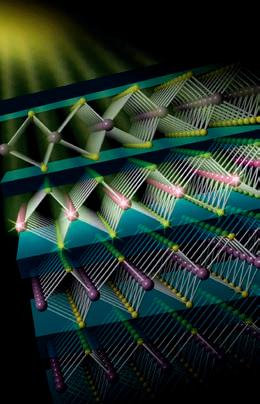
That growth rate, known as Moore’s Law, has been gospel in the electronics world for more than half a century, but it may be nearing its end, says Deep Jariwala, Assistant Professor in Electrical and Systems Engineering. With state-ofthe-art transistors already smaller than a hundred silicon atoms across, it will eventually be impos sible to go any smaller, creating a minor crisis for engineers: If silicon is already pushed to its limit, how can they improve upon the performance of electronics in the future?
“That’s kind of the pipe dream for a lot of people in my field,” Jariwala says. “In theory, the only electronic component would be a powerful laser sitting beside a computer. Instead of plug ging the computer into an outlet, you’d plug it into the laser using a fiber optic cable.”
Creating a light-based computer, however, will first require developing entirely new mate rials. Unlike optics, a transistor can act as a sort of electronic valve that throttles or amplifies a signal. Connect a few of these “valves” in the right way, and they can perform basic computer logic. While existing optical components can stop or even split a light signal, they can’t easily amplify it, making them far less useful for computation. There’s also an issue of size, Jariwala notes: Silicon components can be reduced to a nearatomic scale, but fiber optic channels, or “wave guides,” can’t yet shrink beyond a certain limit. Once they become smaller than the wavelength of light they’re carrying, they start to diffuse the light’s energy, potentially hindering any transmis sion of data.
SPEEDING DATA
Although challenges like these are formidable and won’t be solved anytime soon Jariwala
DEEP JARIWALA
Deep Jariwala’s research lies at the intersection of solidstate opto-electronics and emerging low-dimensional materials. Specifically, he combines new techniques to assemble, grow and integrate nanostructured materials, including molecular materials with state-of-the-art nanofabrication methods to create novel electronic and photonic devices. He uses spatially and spectrally resolved current and photon spectroscopy as well as scanning probe techniques to understand charge and energy transport mechanisms across atomically abrupt and hybrid interfaces which lie at the core of modern semiconductor opto-electronics.
thinks engineers could reach a more modest goal in the near future. While tiny silicon transistors would still do the heavy lifting within a computer processor, optics could be used to shuttle data between different points on the chip at a much higher speed than is currently possible.
This concept, called “hybrid electronic photonic computation,” is already underway with major chip manufacturers, meaning that ultra-fast processors that incorporate light trans mission could be sold within the next decade. Once commercially available, these hybrid chips would be a major boon to high-performance computers, which are used to run enormous climate models, process huge data sets and recog nize the contents of images. Shuffling data around at the speed of light would not only enable faster computation, but more energy-efficient proces sors as well, saving time and reducing the cost of keeping the computer running.
In the meantime, Jariwala is already exploring other, more immediate uses for optical electronics. He and his lab are creating ultra-thin materials called “superlattices,” multi-layered sandwiches of materials that are each just a few atoms tall. Despite the material’s incred ible thinness, Jariwala can effectively produce or manipulate a beam of light simply by changing its shape. This trait could lead to vast improve ments in light sensors, like those used in cameras or solar panels, as well as new displays and other technologies like light modulators.
“Photonics has already enabled things that have transformed our lives, like new light sources, sensors and high-speed internet connec tions,” says Jariwala. “In terms of computing using photons, work within the field may not yet be visible to a broad cross-section of society, but it will definitely add constructively to everyone’s lives moving forward.”
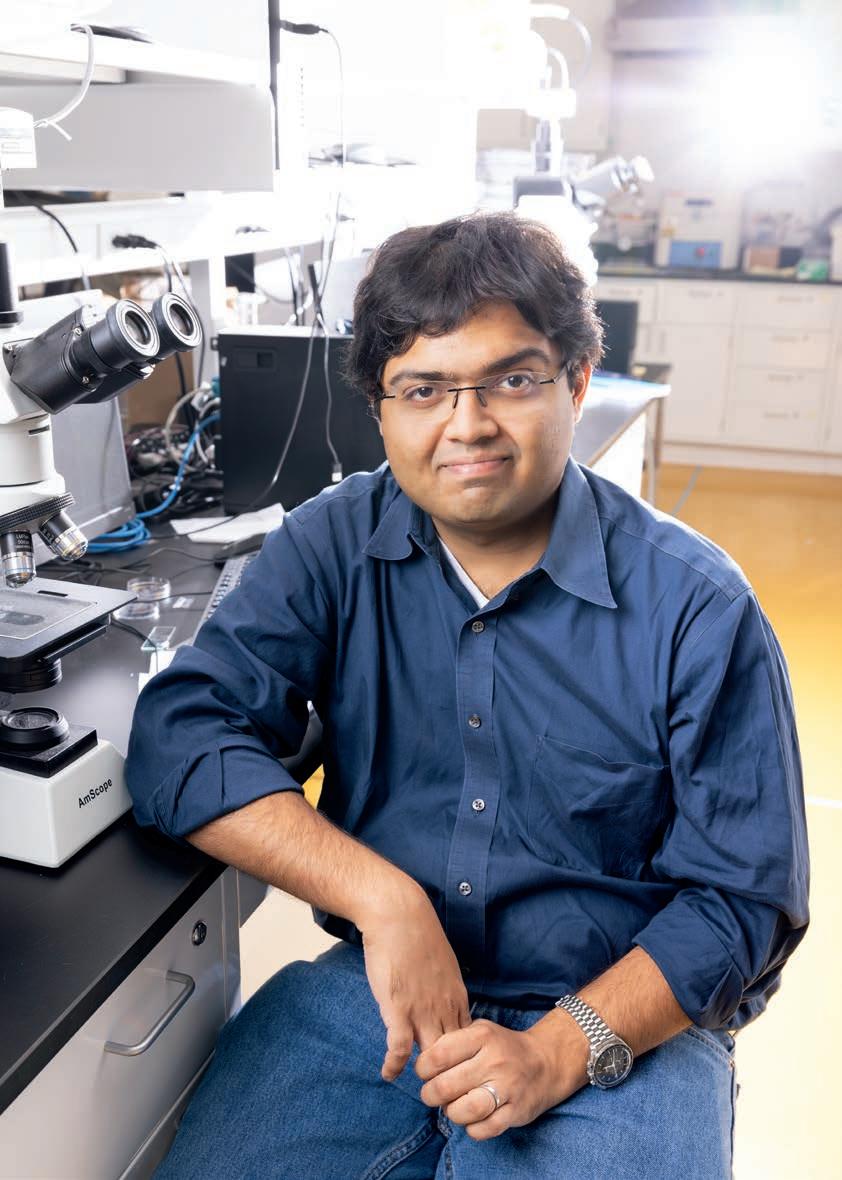
“In terms of computing using photons, work within the field may not yet be visible to a broad cross-section of society, but it will definitely add constructively to everyone’s lives moving forward.”
Sculptural Sweets
BY David Levinin a few short decades, 3D printing has gone from unique to ubiquitous. It’s used nearly everywhere, from making toys and gadgets in classrooms nationwide to manufacturing new parts on the International Space Station. Ellie Weinstein (MEAM’19) has a different venue in mind for this emerging technology, however: the kitchen.
Instead of printing plastic or metal, Weinstein is tweaking the technology to print chocolate in elaborate shapes and patterns. Her company, Cocoa Press, which she founded in 2019 as an undergraduate at Penn Engineering, makes confectionaries out of delicate, lace-like choco late strands that crisscross one another as they are laid down by a modified printer, gradually building up a lattice of edible artwork.
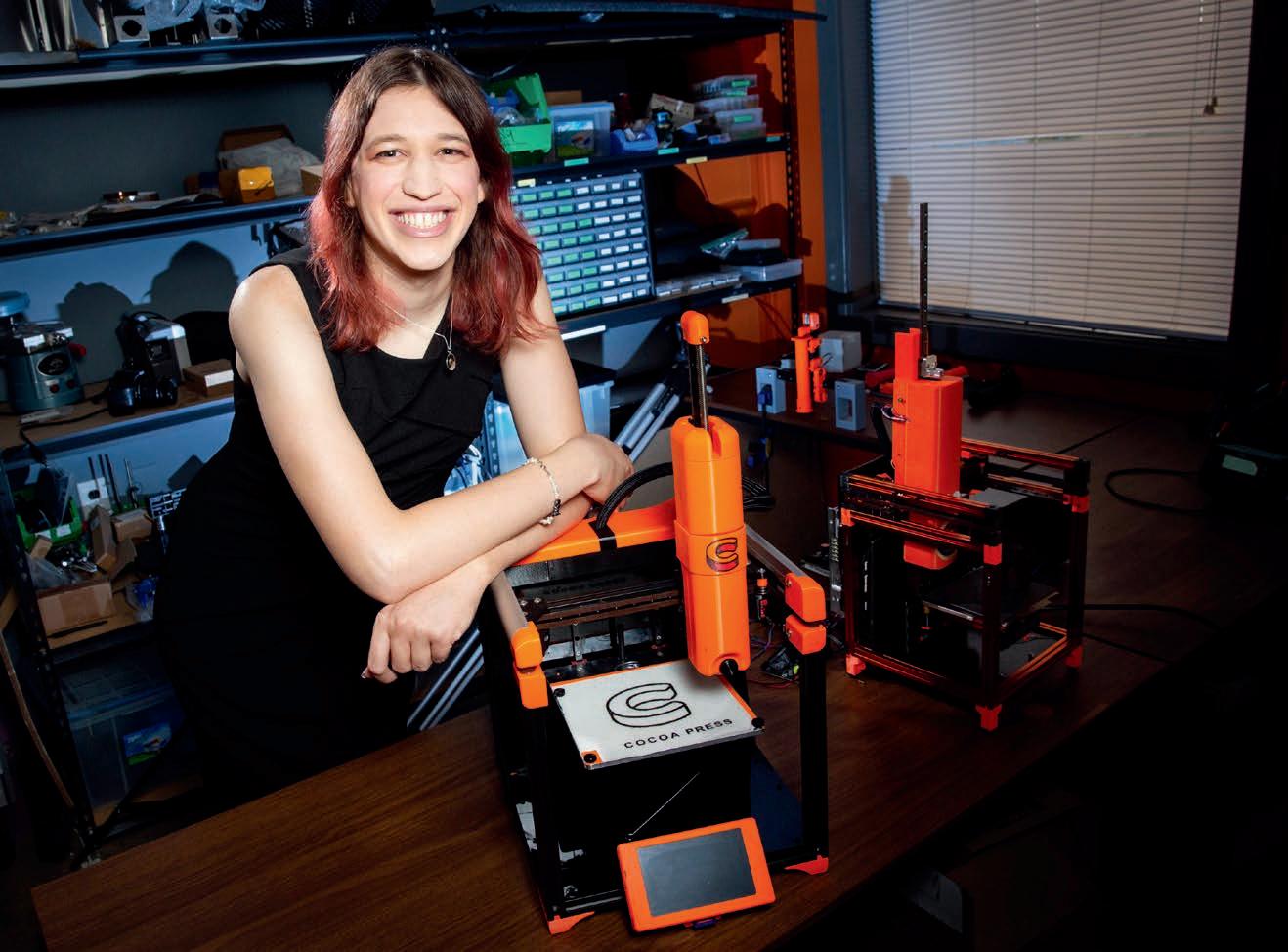
“3D printing lets you create intricate textures that are not possible to mold,” she says. “The printed chocolates melt in your mouth in a different way than a solid or hollow molded shape does.”
Printing chocolate as a business wasn’t Weinstein’s original goal. Her idea initially started as a hacked-together high school project in 2014.
Once at Penn, Weinstein kept tinkering and improving the device as a hobby, incorporating what she gradually learned while working on her degree in Mechanical Engineering and Applied Mechanics. After increasingly positive feedback on her idea, she started to realize its commercial potential, taking entrepreneurship classes while fine-tuning her 3D printer for her Senior Design project.
“It was perfect. Our team had access to a machine shop to fabricate all the parts, and we would reach out to professors for help with tech nical roadblocks. We had access to mechanical engineering experts for the device itself, profes sors working in thermodynamics for figuring out how to precisely heat the chocolate and fluids professors to help troubleshoot how the chocolate flows,” she recalls. After graduation, financial support from Penn Engineering’s Miller Innovation Fellowship and the Pennovation Accelerator (a program that helps to jumpstart local businesses) helped her create the devices and confections that she now sells commercially.
A STICKY PROBLEM
Printing a material like chocolate isn’t as easy as it sounds. As a material, it’s finicky: In addi tion to mixing just the right ratios of cocoa, sugar and fats, making successful solid chocolate requires heating and cooling the mix at just the right temperatures and times, which forces fatty acids within it to crystallize into predictable struc tures. There are also storage issues to consider. If the concoction isn’t heated correctly, the end product will eventually “bloom,” leaving an unsightly (although harmless) powdery substance on its exterior as fat content comes to the surface.
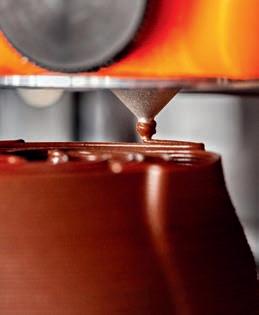
“The hardest part is regulating the tempera ture within a narrow range as the chocolate prints,” she says. “Stock 3D printers are not meant for precise temperature control, and so we’ve had to do a lot of custom modifications to get that to work.” The nozzle of the printer, for instance, has to be able to warm chocolate held in a stainless steel cartridge just enough to turn it into a gel-like consistency, so a plunger can then squeeze it out into a fine line. Once the chocolate is laid down, the printer’s bed has to instantly cool that line back down again to maintain its shape. If that weren’t enough, Weinstein says, all parts of the machine have to be food safe, easy to disassemble and simple to wash.
TEMPERATURE CHECK
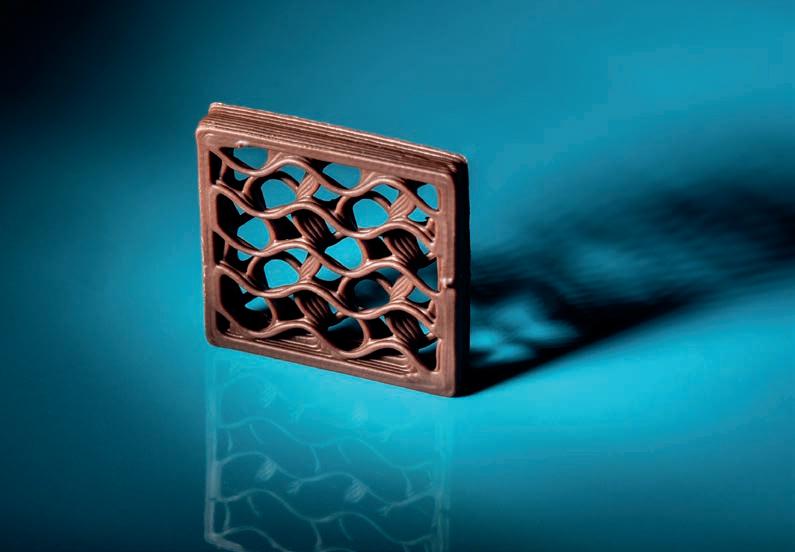
In previous iterations, Weinstein got around some of the temperature issues by surrounding the printer with a carefully controlled environment effectively a high-tech mini fridge ensuring that the extruded chocolate stays firm and can build up complex 3D layers.
At the moment, however, she’s working to make the machine simpler, cheaper and easier to use. Weinstein is experimenting with adding new types of chocolates that are more forgiving, allowing users to print them in a broader range of temperatures. She’s also close to releasing a countertop model that doesn’t need a complex enclosure, an improvement that will lower the cost of the assembled device by more than 60% (a build-your-own-kit model will also be avail able for even less, she adds). Weinstein hopes that this move will make her device more broadly accessible to consumers, putting it within reach of independent pastry chefs and adventurous home cooks.
“A lot of what I see as the core of engineering is just breaking down these complex problems into smaller ones. And often, when you Google them, you’ll find someone has already solved most of those smaller problems,” she says. “It’s just a matter of putting them all together in the right way.”
The printer nozzle warms the chocolate into a gel-like consistency so it can be squeezed into a fine line that is then instantly cooled to maintain the desired shape.
“3D printing lets you create intricate textures that are not possible to mold,” says Weinstein. “The printed chocolates melt in your mouth in a different way than a solid or hollow molded shape does.”
small
small
 BY
BY
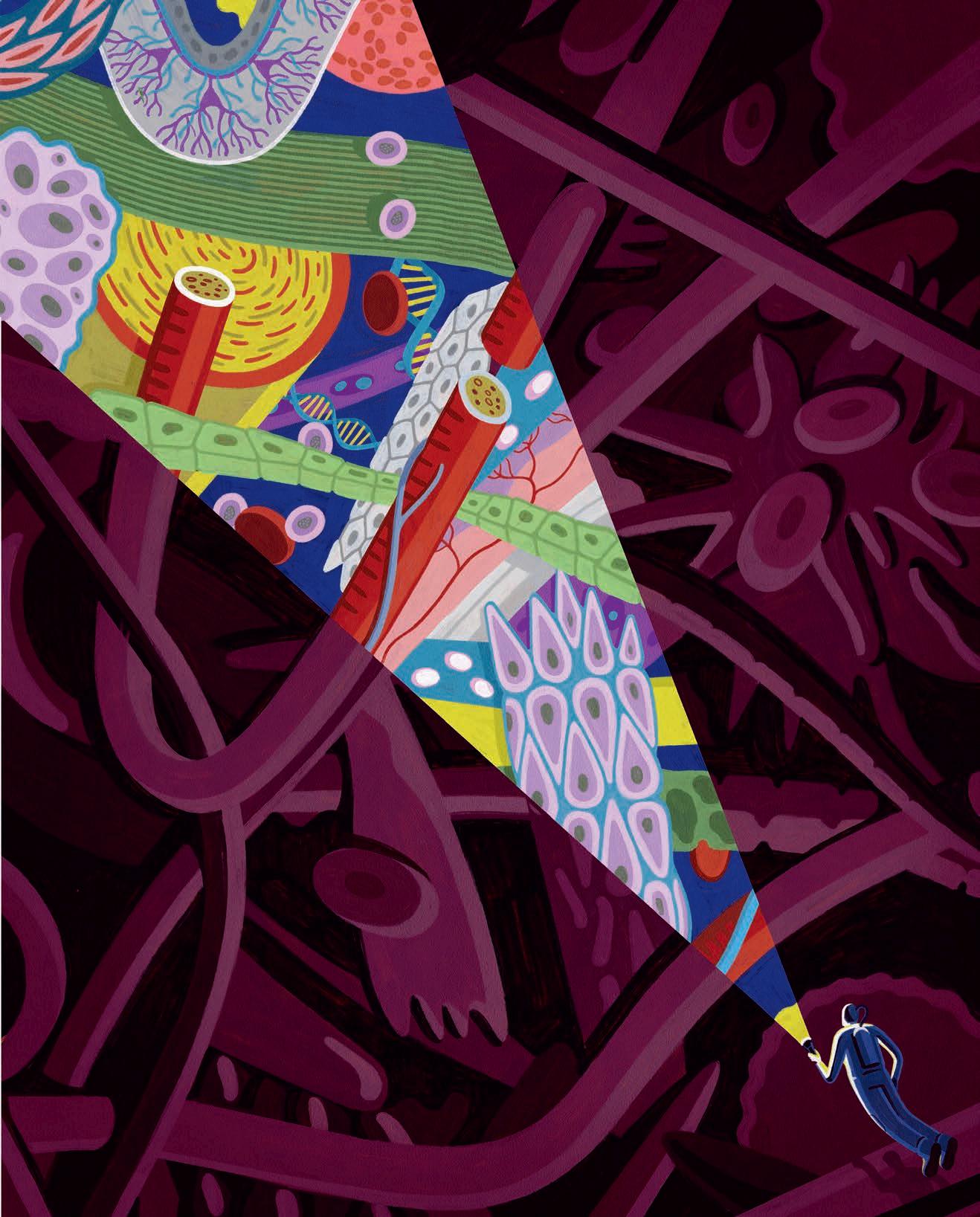
n the 1966 sci-fi film Fantastic Voyage, a submarine and its crew are miniaturized so that they could travel through the body of an injured man and attempt to repair damage within his brain. While we can’t shrink surgeons down to the size of a neuron, engineers are rapidly advancing technologies that operate at scale with cells and their even smaller compo nents. Technology at the micro- and nanoscales opens up a new frontier of opportunities when it comes to fighting disease and increasing the quality of human health.

In order to centralize and concentrate research efforts in this space, the University of Pennsylvania has dedicated a $100 million invest ment to develop new laboratories and hire new faculty, culminating in the Center for Precision Engineering for Health ( CPE4H ). Directed by Daniel A. Hammer, Alfred G. and Meta A. Ennis Professor in Bioengineering and in Chemical and Biomolecular Engineering, CPE4H will enable Penn Engineers to develop technologies that will fight future pandemics, cure incurable diseases and extend healthy life spans around the world.
“Penn is a unique environment where inno vations in healthcare can emerge very rapidly, as we’ve seen with the development of CAR-T cancer immunotherapy, and the design and delivery of m RNA vaccines,” says Hammer. “Engineering
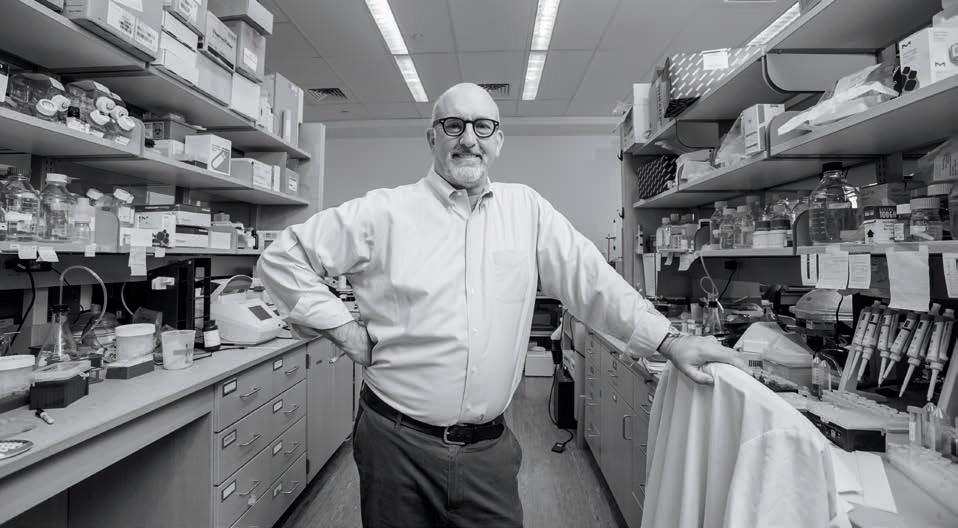
plays a central role in making those technolo gies functional and maximizing their impact, and CPE4H is a golden opportunity to improve these and other novel technologies in a way that actu ally helps people.”
Engineers in CPE4H, the centerpiece of Penn Engineering’s Signature Initiative on Engineering Health, will focus on innovations in diagnostics and delivery, cellular and tissue engineering, and the development of new devices that inte grate novel materials with human tissues. The center will leverage expertise in both biological and non-living materials to increase our under standing of how cells and tissues operate in order to develop new treatments and medical innova tions. “ CPE4H brings together innovators from Penn Engineering and across the University,” says Vijay Kumar, Nemirovsky Family Dean of Penn Engineering. “This further strengthens our existing ties with the Perelman School of Medicine, and focuses our efforts on technologies like biological materials, nanofluidics and biofabrica tion to solve the biggest health challenges.”
CPE4H is focused on how advances in molec ular medicine, such as sequencing and the genome, might give way to personalized treat ments. Its efforts will catalyze the ability to move healthcare from providing one-size-fits-all solu tions to a system that can recognize the unique state of each individual to provide the best care. With a focus on precision engineering for health, the pages that follow include four exam ples of Penn Engineering faculty who are at the forefront of developing new technologies based on our increasing understanding of biology and human physiology to create new technologies for healthcare.
“Penn is a unique environment where innovations in healthcare can emerge very rapidly, as we’ve seen with the development of CAR-T cancer immunotherapy, and the design and delivery of mRNA vaccines.”Daniel A. Hammer
a single sample and changes in living cells and tissues can be tracked over time. She first developed this method during her postdoctoral training at Massachusetts General Hospital under the supervision of Jonathan Carlson and Ralph Weissleder.
The method uses “click” chemistry, which is a bioorthogonal, non-toxic and rapid reaction that allows the team to highlight the desired biomarkers in the samples without destroying them each time a microscopy cycle is run.
Tracking Living Tissues
THE CHALLENGE
w hen scientists create methods to detect disease biomarkers, they give healthcare providers better tools to prop erly diagnose and treat patients. However, limitations to obtaining this information, especially when using living cells and tissues from patients, prevents a complete picture of what is unique about a case and decreases the chance that the best course of treatment can be identified.
THE STATUS QUO
Several techniques exist for identifying multiple biomarkers in cells, but they are usually not compatible with observing changes over time in living cells or are limited by a set number of biomarkers
that can be profiled. The chemicals used to profile multiple (>5) biomarkers are toxic to the cells, preventing live cell monitoring. Due to this limitation, a full understanding of the protein expressions of the living cells could not be obtained and a clear picture of what is actually occurring during the course of cellular changes was out of reach.
THE KO LAB’S FIX
Jina Ko, Assistant Professor in Bioen gineering, is working to overcome this limitation with a method known as “scis sion-accelerated fluorophore exchange” (or SAFE), a new way to detect biomarkers in cells that is highly gentle and allows for high multiplexing via cyclic imaging so that more biomarkers can be identified in
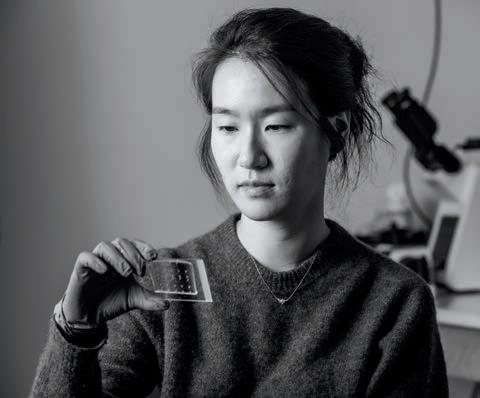
SAFE can track nearly as many markers as necessary with ultra-fast kinetics because researchers can repeatedly stain cells in a living sample using the devel oped probes with fluorophores and then release those fluorophores following the imaging, repeating this cycle multiple times to achieve multiplexing. A cycle can profile 3 biomarkers, so if a researcher needs information on 15 markers, they would run the cycle 5 times to create the cell profile that they need within an hour.

Understanding activity in an individu al’s living samples over time addresses the issue of subtlety and heterogeneity when identifying a patient’s unique disease response and allows for more tailored treatment approaches.
“You can’t identify a treatment that works for the average person, apply that treatment to everyone and expect the best outcomes,” says Ko. “Using this method, if we want to administer a therapy to a patient, we could remove a sample of their cells and use that sample to try different therapeutic options. After tracking the sample, we could predict if the patient would respond well to therapy A, but not therapy B. Our goal is that this technology will be applied in the clinic to help patients.”
An Inventory of Immunity
THE STATUS QUO
Prior methods of understanding interac tions between T cells and antigens could only get a picture of one or two of these four elements because of technology constraints. Other roadblocks included that cells cultured or engineered in a laboratory setting are not in a natural environment so they won’t express genes or proteins in the way T cells would in the body, and technologies that assess the antigen specificity of T cells were not cost-effective for looking at large numbers of antigens.
THE JIANG LAB’S FIX
Two different individuals’ T cells will not have the same set of T cell antigen receptors in their vaccine-responding cells, even though they received the same vaccine.
The Jiang Lab’s technology is essen tially a method for getting a “full-body scan” of an individual’s T cells and creates a catalog of the different types of T cells and the antigens they respond (or don’t respond) to, paving the way for the ability to better target immune therapies to an individual patient.
INSIDE THE JIANG LAB
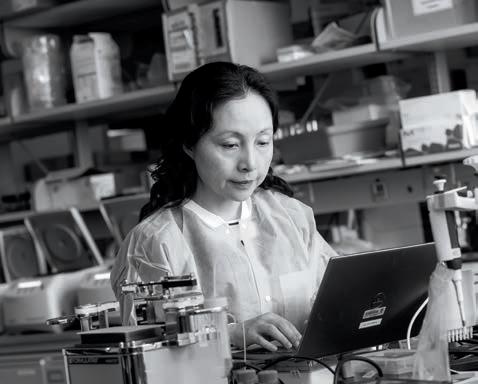
THE CHALLENGE
in order to create personalized immune therapies, researchers need to untangle what is happening between an individual patient’s immune cells and the antigens that they interact with on a molecular level. Immune cell-antigen interactions need to be understood in four different areas in order to create a full picture: the unique genetic sequence of the T cell’s antigen receptors, the antigen specificity of that cell, and both the gene and protein expression of the same cell.
The lab of Jenny Jiang, J. Peter and Geri Skirkanich Associate Professor of Innovation in Bioengineering, developed a technology called TetTCR-SeqHD, which solves these problems. Using this tech nology, scientists can now simultaneously profile samples of large numbers of single T cells in the four dimensions using highthroughput screening.
Healthy humans can have hundreds of billions of T cells in their bodies, and these cells are specialized to respond to different antigens. This is further compli cated by the fact that the T cells that respond to antigens like those delivered in vaccines are different in different individuals.
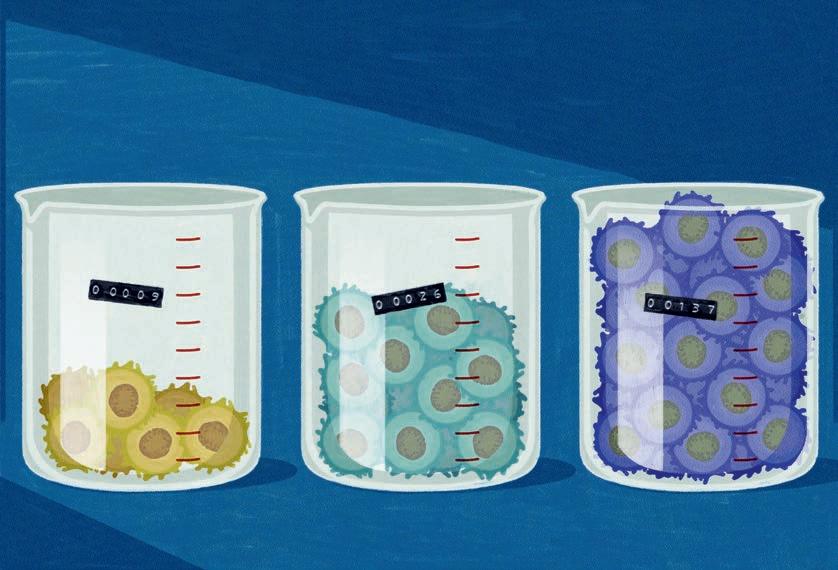
To create this catalog, hundreds of thousands of T cells are mixed with hundreds of antigens in a test tube and allowed to bind. Afterward, those cells are separated inside a machine that has hundreds of thousands of micro wells that each hold only a single cell. The individual cells are broken down and the genetic material is captured on a barcoded microbead, which is then used for sequencing and amplification so that researchers can identify the types of T cells according to the antigens they responded to and how many of those cells there are.
“Individual T cells are unique, and that’s the challenge of using one treatment to fit all,” says Jiang. “Identifying antigen specificity and creating therapies that target that specificity in an individual’s T cells will be key to truly personalizing immune therapies in the future.”
Cell-Sized Robots
A circuit board serves as the device’s torso and brain, and photovoltaic cells (think solar panels) decorate its surface. To enable movement, the group devel oped a new class of actuators called surface electrochemical actuators, or SEAs, which are platinum strips with rigid panels that serve as jointed legs. The legs fold at the joints when a charge passes through them because atoms from the surrounding water attach themselves to the surface of the platinum when it’s charged, allowing the robot to move. Put together, these pieces allow for a tiny walking robot: Hit the solar cells with a laser and it passes electricity to the legs, causing them to flex and the robot to walk through its fluidic environment.
THE CHALLENGE
since their creation, robots and robotic devices have been used to go places and complete tasks that humans have deemed too “dull, dirty or dangerous.” However, there is not a way for humans to observe, explore or interact with the world of cells and cell-sized matter at scale using robotic devices.
THE STATUS QUO
While for fifty years electronics have been getting smaller and smaller, smarts are only half the story; robots also need bodies and parts that move. Until recently, nobody knew exactly how to build the small actuators that are needed to construct a microscale robot.
THE MISKIN LAB’S FIX
Members of the research team led by Marc Miskin, Assistant Professor in Electrical and Systems Engineering, are harnessing new nanofabrication techniques to create robots that can operate on the same scale as cells and could therefore be used to interact with biology on a cellular level. Their robots can be mass-produced on a silicon wafer using the same techniques used to manufacture microchips, cost less than a cent each and are able to be injected through a syringe.
Measuring 70 microns across, about the width of a human hair or the size of a single-celled paramecium, the devices are too small to be seen with the naked eye, but can be made to move using onboard electronics.
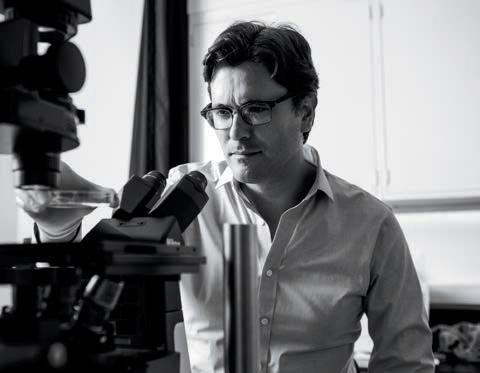
In developing and deploying these robots, researchers could unlock a poten tial treasure trove of diagnostic and treatment capabilities. “We now finally have a match in size between cells and robots that you can communicate with and command,” says Miskin. “Biology is still leaps and bounds more complicated than electronics, but now that there is a foothold in this completely different dimension, what new medicine can you do that you couldn’t before?”
The team continues to improve upon their design, and is currently building more complex circuitry for sensing, computation and control to create robots that could be programmed to carry out specific tasks (like following a tempera ture gradient) automatically. Future plans include building robots specially designed to operate in the body, figuring out how they can work together as a swarm, or developing new tiny sensors to learn about the world around them.
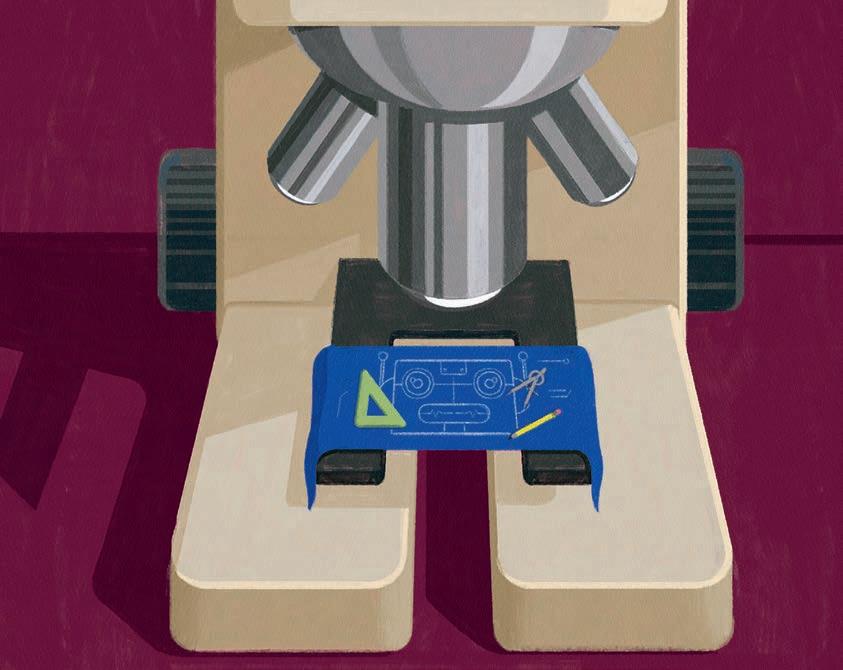
Crossing Biological Barriers
THE CHALLENGE

solid tumors evade the immune system’s ability to attack them in part due to the tumors’ tough, fibrous biological barriers that circulating immune cells can’t cross. Researchers need to identify ways to deliver individualized treatments that can better target these tumors without causing damage to healthy tissues or affecting overall quality of life.
THE STATUS QUO
Current cancer treatments typically involve surgery, radiation or chemo therapy to eliminate solid tumors. These treatments are invasive and can cause numerous negative downstream effects. Newer treatments involve engineering a patient’s immune system to recognize and fight cancerous cells, but are so far only effective against certain “liquid” cancers, where the mutated cells circulate freely in the blood and bone marrow and are small enough to be picked off by the patient’s upgraded T cells. Additionally, existing
methods can also require that the cell engineering take place in a lab rather than directly inside the body.
THE MITCHELL LAB’S FIX
Members of the lab of Michael Mitchell, J. Peter and Geri Skirkanich Assistant Professor of Innovation in Bioengineering, are looking to utilize nanoparticle delivery technology developed by their lab to engi neer a different type of immune cell, the macrophage, in order to fight solidtumor cancers from the inside.
Thanks to the widely publicized tech nology behind the m RNA -based COVID vaccines, many people know that you can use lipid nanoparticles (LNPs) to deliver genetic instructions inside a cell in order to get that cell to change the way it func tions. In the case of the vaccines, the nanoparticles smuggled m RNA inside of muscle cells in the upper arm to get those cells to produce the spike proteins of the COVID virus, which immune cells could then see, attack and create memory immune cells to fight against future infec tion with the actual virus.
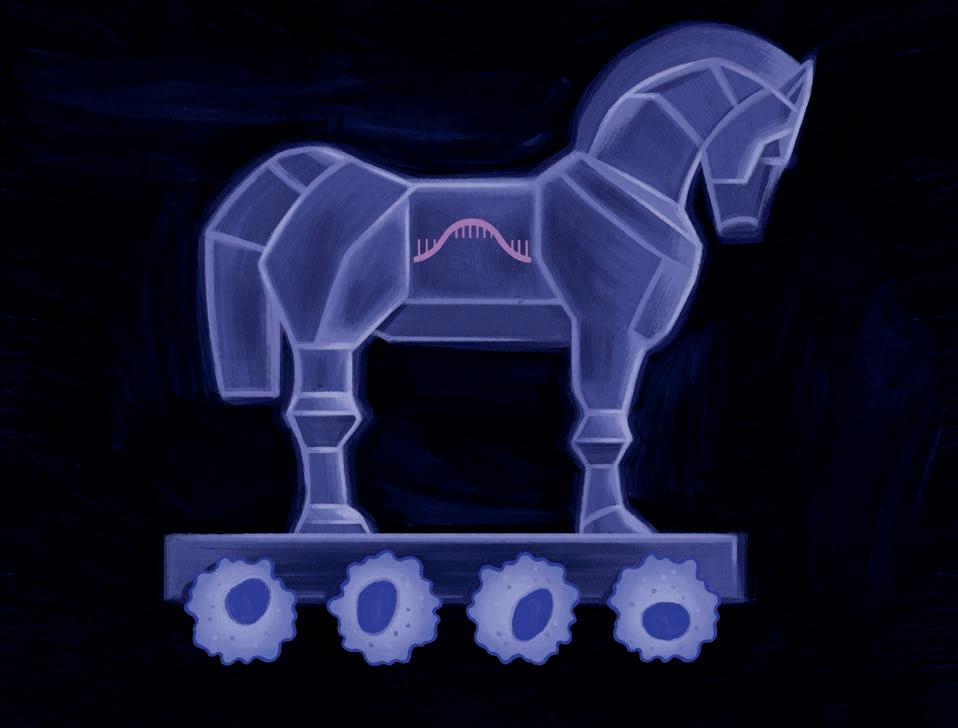
“One of the longstanding challenges that we face in the context of cancer and immunotherapies is that every tumor has unique antigens that are specific to patients.”
The Mitchell lab is using the LNP method to carry mRNA and DNA sequences inside of macrophages, a type of immune cell that can consume tumor cells if engi neered correctly. In theory, a patient would receive an injection carrying the LNP payload, and the macrophages, whose name literally means “big eaters,” would take up the genetic sequence, alter their function and be able to recognize a patient’s own unique tumor cells in the body.
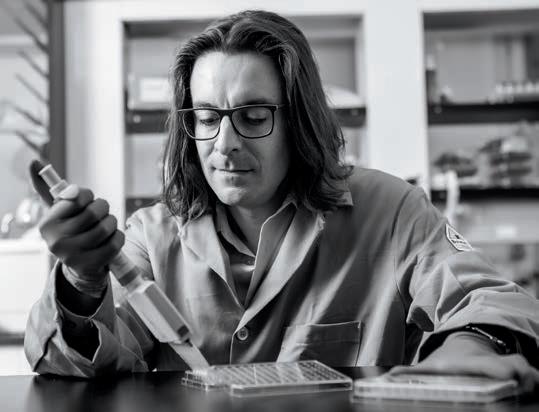
Because of the way macrophages operate, they could cross the tumor’s biological barrier and attack the cells, destroying the tumor from the inside. An added benefit of the Mitchell Lab’s tech nology is that the destroyed tumor cells would then also allow other immune cells to present their antigens to circulating T cells, which could then learn to fight those same cancer cells in the future.
In contrast with other engineered macrophage work, scientists using this method would not need to remove the macrophages and engineer them outside the body. The Mitchell Lab’s technology could mean changing the future of solidtumor cancer treatment from the status quo to one of receiving an injection.
“One of the longstanding challenges that we face in the context of cancer and immunotherapies is that every tumor has unique antigens that are specific to patients,” says Mitchell. “This is why we’ve had a lot of trouble developing targeted therapies. Personalizing an approach by harnessing an individual’s immune system gives each patient a greater chance of a positive outcome.”
CPE4H SEED FUNDING
The Penn Center for Precision Engineering for Health (CPE4H) recently announced its inaugural round of seed grants. These projects address healthcare challenges in several key areas of strategic importance to Penn: synthetic biology and tissue engineering, diagnosis and drug delivery, and the development of innovative devices. Judged on technical innovation, potential to attract future resources and ability to address a significant medical problem, the following four projects were selected to receive funding:
EVOLVING AND ENGINEERING THERMAL CONTROL OF MAMMALIAN CELLS
Led by Lukasz Bugaj, Assistant Professor in BE, this project will engineer molecular switches that can be toggled on and off inside mammalian cells at near-physiological temperatures. Successful development of these switches will provide new ways to communicate with cells, an advance that could be used to make safer and more effective cellular therapies.
A
QUANTUM SENSING PLATFORM FOR RAPID AND ACCURATE POINT-OF-CARE DETECTION OF RESPIRATORY VIRAL
INFECTIONS
Combining microfluidics and quantum photonics, Liang Feng, Professor in MSE and ESE, Ritesh Agarwal, Professor in MSE, and Shu Yang, Joseph Bordogna Professor in MSE and CBE, are teaming up with Ping Wang, Professor of Pathology and Laboratory Medicine in Penn Medicine, to design, build and test an ultrasensitive point-of-care detector for respiratory pathogens.
VERSATILE COACERVATING PEPTIDES AS CARRIERS AND SYNTHETIC ORGANELLES FOR CELL ENGINEERING
Amish Patel, Associate Professor in CBE, and Matthew C. Good, Associate Professor of Cell and Developmental Biology in Penn Medicine, will design and create small proteins that self-assemble into droplet-like structures known as coacervates, which can then pass through cell membranes in order to deliver cargo that modulates cell behavior or be maintained as synthetic membraneless organelles.
TOWARDS AN ARTIFICIAL MUSCLE REPLACEMENT FOR FACIAL REANIMATION
Cynthia Sung, Gabel Family Term Assistant Professor in MEAM and CIS, will lead a research team that includes Flavia Vitale, Assistant Professor in Neurology and BE, and Niv Milbar, Assistant Instructor in Surgery in Penn Medicine. The team will develop and validate an electrically driven actuator to restore basic muscle responses in patients with partial facial paralysis.
PENN ENGINEERING POSTDOCTORAL FELLOWS LEAD THE WAY ON GROUNDBREAKING RESEARCH
BY Amy BiemillerNEXT-GEN INNOVATORS

Postdoctoral fellows are an integral part of the success of any top-tier research university. While they are considered trainees who benefit from a full-time research experience and mentorship from investigators who are often at the forefront of their fields, they are also essential contributors to new research that advances their institution and positively impacts the world.
“In a word, postdocs make it possible for us to define the leading edge of science and engineering,” says David Meaney, Solomon R. Pollack Professor in Bioengineering and Senior Associate Dean of Penn Engineering. “They are the future leaders in groundbreaking research.”
RESEARCH FOCUS
Human-centered artificial intelligence, automated story generation and speech processing
One focus of my research is to positively impact the lives of adults with autism by developing augmentative and alternative communication technology, helping them to be more independent, expand their ability to communicate and increase their social interaction.”
PERSONALIZED FOCUS
postdoctoral work is often the next step and the foun dational element for future career scientists and faculty who have earned their doctoral degrees. At two or three years in length, the postdoc experience provides addi tional opportunities to be mentored by and collaborate with highly experienced principal investigators and to publish independent and collaborative research in a seminal area of interest.
“After five or six years in a Ph.D. program, postdocs come to us for their education capstone, an opportunity to personalize their education, learn their strengths and forward their research ideas,” Meaney explains. This can involve a widening of their research focus, drilling down on a specific interest from their doctoral experience, or both.
That’s the route Lara Martin took when she came to Penn Engineering after earning a Computing Innovation Fellowship from the Computing Research Association. “I reached out to Chris Callison-Burch because one of his students was working on automated story generation, a subfield of AI that teaches computers how to tell stories. That’s what I focused on during my Ph.D.,” she says.
Working in the lab of Callison-Burch, Associate Professor in Computer and Information Science, has helped Martin broaden her research focus to pursue her passion for human-centered artificial intelligence with a focus on natural language.
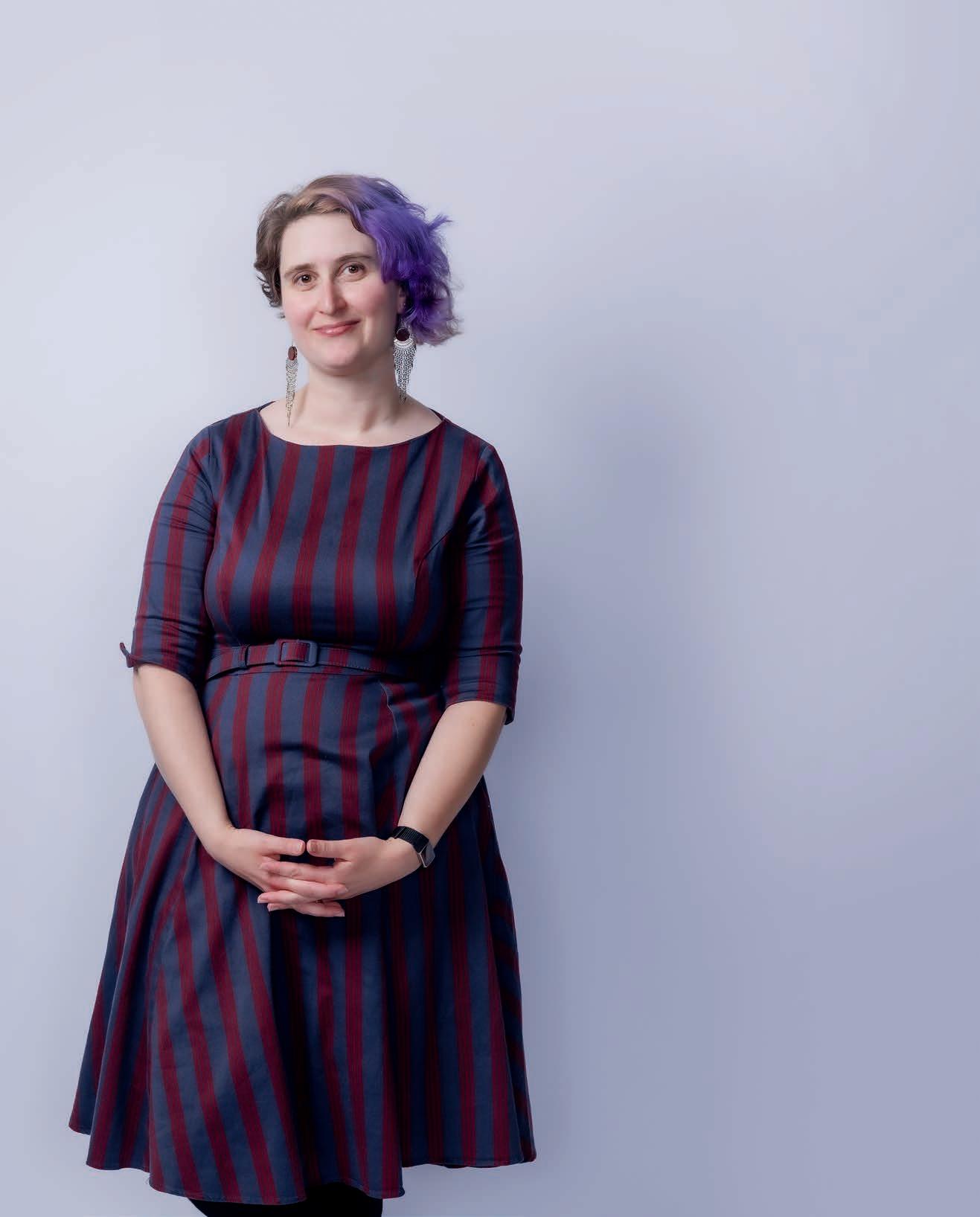
“As I started my Ph.D., I wanted to work on a cool AI project that could have an interesting speech component, but even after five years, I never got around to adding speech to it as I had originally planned,” she explains. “That’s where I want to focus my research.”
Like most postdocs, Martin balances her lab time with other responsibilities. “I co-taught the Interactive Fiction and Text Generation class last spring, so lesson planning, class organization and teaching took up a good bit of time,” Martin says. “I have a lot of different projects going on simultaneously, so on any given day, I could also be programming, running models, conducting interviews with participants, coding interviews or writing papers. I also have meetings where I mentor graduate and under graduate students who are doing research projects with me.”
JULIA (KATE) BRYNILDSEN
PH.D. IN NEUROSCIENCE UNIVERSITY OF PENNSYLVANIA PERELMAN SCHOOL OF MEDICINERESEARCH FOCUS
CREATIVE COLLABORATIONS
“
i n science and engineering, it’s important for us to always push the boundaries. Postdocs help us achieve that,” Meaney shares. “The highest-risk ideas for research that you have as a faculty member are great for post docs to explore. They grab your meaning and take off to create the rest of the story, making discoveries and building on a body of knowledge that facilitates education and learning.” These opportunities can help launch post docs into meaningful careers in academia, government or public enterprises.
Julia (Kate) Brynildsen sought a postdoc position that would expose her to advanced network science approaches as she investigates how the brain responds to stimuli in health and disease states. She applied for a position with Dani S. Bassett, J. Peter Skirkanich Professor in the Departments of Bioengineering and Electrical and Systems Engineering.
“I think it can be easy to focus on our limitations in science. Dani is always looking toward possibilities and creative solutions to problems, which inspires me,” Brynildsen says. “They are constantly providing me with opportunities that are tailored to my specific interests and goals, whether by introducing me to a collaborator who shares my interests, involving me in a project that will expand my training in a particular direction, or noti fying me about an opportunity to present my research.”
Brynildsen’s long-term goal is to obtain a tenure-track faculty position at a research-intensive institution, and she feels her experience at Penn Engineering is preparing her for success in that next step.
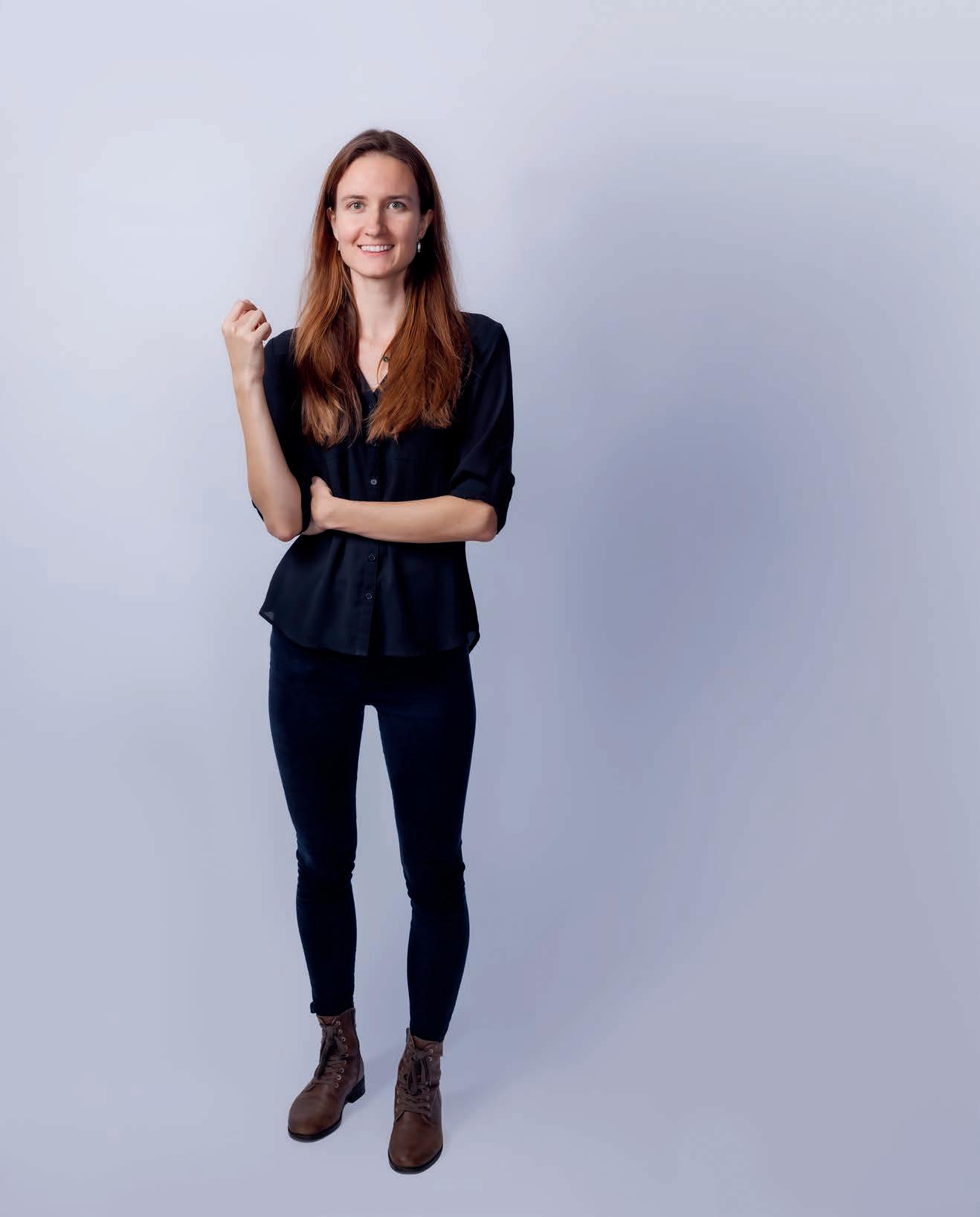
“The outstanding training I am receiving in cutting-edge approaches in network science, plus the opportunities to lead collaborative projects and network with scientists in and outside of the School, are building my confidence and my marketable skills,” she adds.
EXPLORING NEW FRONTIERS
p enn e ngineering postdocs arrive at the University from all around the world. Currently, more than 150 post docs from 21 countries play a vital role in research and teaching in the School. Perhaps one of the greatest bene fits these postdocs receive in choosing Penn Engineering is the opportunity to join a global network of scientists and creative thinkers that can be an invaluable asset throughout their careers.
“These talented scientists go on to leadership roles in academia and industry, representing the University and Penn Engineering in exceptional ways,” Meaney says. “While they are here, they contribute greatly to the multi-intellectual fabric of our university and inspire future scientists. Science is better as a melting pot, and the School is better because of our postdocs.”
Developing predictive models to understand how the brain transitions between states associated with health and disease
“In the long run, I hope that this research will reduce disease burden by helping us identify neural markers that might explain individual differences in treatment response and aid treatment personalization.”
“I was looking for a program where I would be able to combine my computational skills with the skills of people working on experimental models,” says Aayush Kant, a postdoc working with Vivek Shenoy, Eduardo D. Glandt President’s Distinguished Professor in Materials Science and Engineering. “Exposure to literature early in my Ph.D. convinced me that collaborations are key to good research in my area. Penn offers many centers for multidisciplinary research, with leaders of their respective areas working together to create a highly collaborative environment.”
Kant’s research focuses on biophysical characteriza tion of cellular and nuclear behavior and the long-term mechanochemical impact of traumatic brain injuries. Working with Shenoy has provided Kant with opportuni ties to approach biological problems as an engineer.
“Vivek’s background in electrical engineering and physics plus the collaborative opportunities in his lab have introduced me to innovative experimental and imaging techniques that are a great fit and have helped to elevate my research in biophysics,” he says.
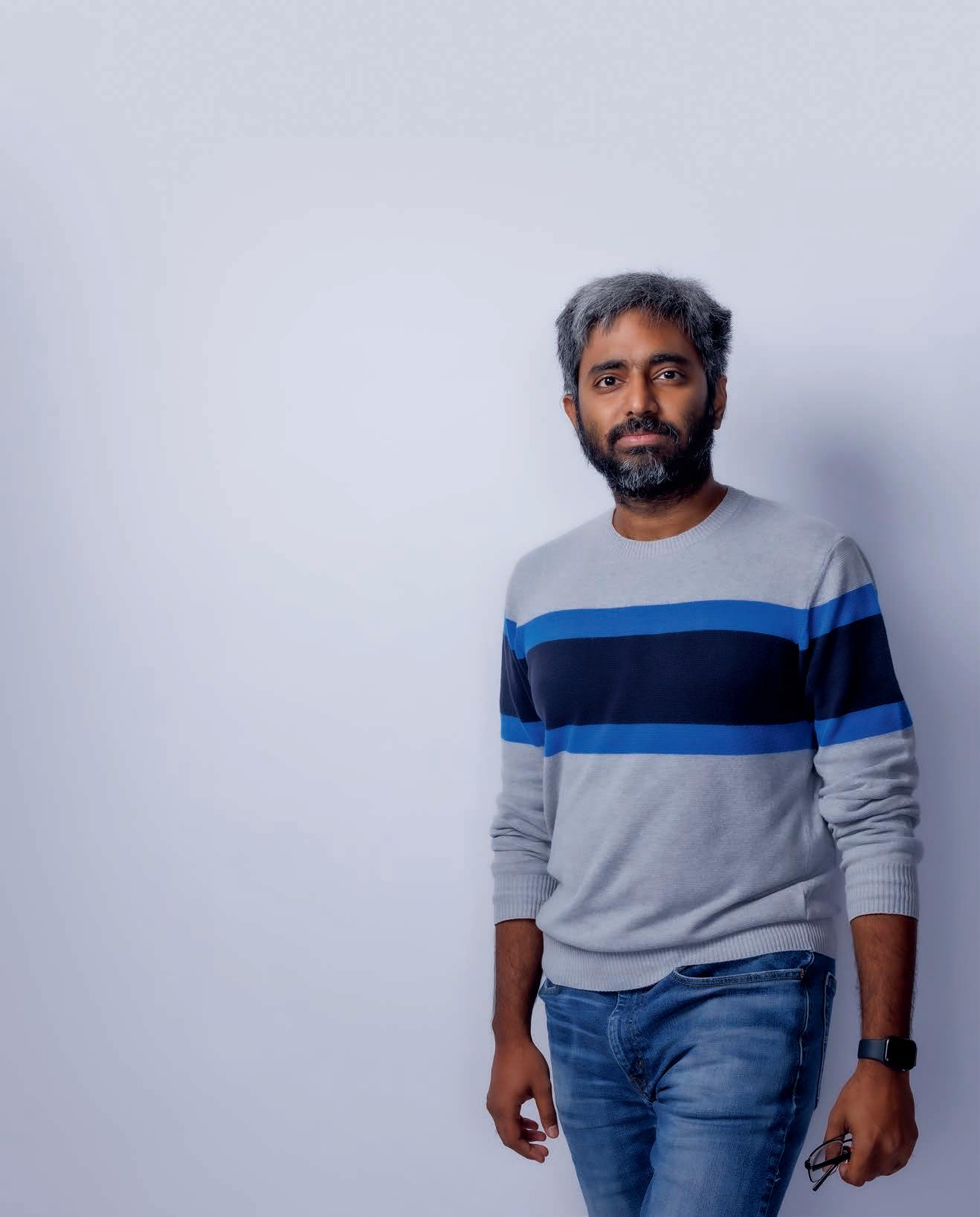
At the University, Penn Engineering postdocs benefit greatly from the access to researchers in different fields and top-flight resources. “Postdocs here are free to explore interdisciplinary collaborations within the School and across Penn,” says Meaney. “In addition, they can connect with our centers and institutes that are by design at the front lines of science and technology research.”
For Penn Engineering, postdoc success brings a tremendous sense of pride to faculty and students. “We want to see our postdocs shine while they are with us,” Meaney says. “But we are especially proud when they go out into the world to make it a better place. We know that more than a little bit of Penn Engineering goes with them.”
AAYUSH KANT PH.D. IN MECHANICAL ENGINEERING INDIAN INSTITUTE OF TECHNOLOGY, MUMBAIRESEARCH FOCUS
Biophysical characterization of cellular and nuclear behavior and the long-term mechanochemical impact of traumatic brain injuries
I hope that my research results in a better understanding of the physical response of biological systems. Such understanding can lead to better preventative and clinical management of injury and disease.”Skates McGee Turtle Duck Mr. Odee Vampyropoda Boxee
THE ART AND SCIENCE OF VIDEO GAME DEVELOPMENT
BYin today’s ever-expanding world of content and entertainment, video games have taken center stage. From PC to console to mobile gaming, and now to e-sports and competitive gaming, video games are more than hobbyist pastimes they are a massive industry of dedicated players and profes sionals who are seeking the next great innovation in gaming and gaming technology.
Penn Engineering students are uniquely equipped to navigate the modern gaming industry as their training in the Digital Media Design (DMD) program prepares them to approach game devel opment with technical rigor and creative insight.
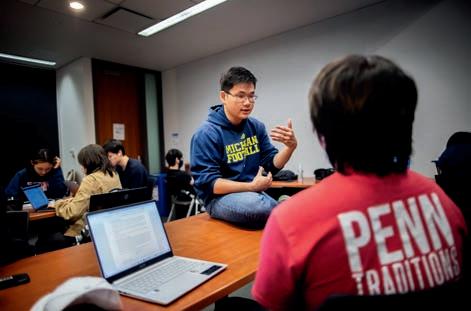
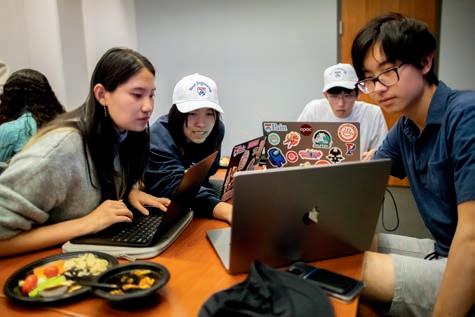
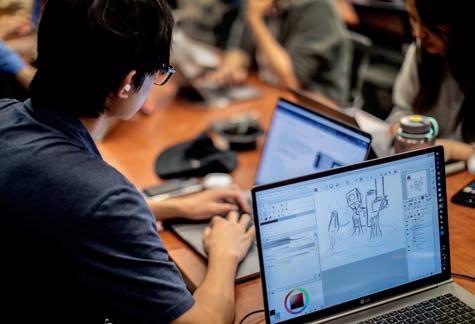

“The way the DMD program at Penn Engineering works is that there is an absolute technical foundation and then you build from there,” shares Steven Flisler ( DMD ’06), Vice President of Original Content and Executive Producer of Twitch Rivals for Twitch, an interac tive livestreaming service for content spanning gaming, entertainment, sports, music and more. “My experience with DMD taught me how to blend art and science, which has shaped the work I do today to create great entertainment experiences.”
DMD is designed for those interested in computer programming, mathematics, computer graphics, animation, virtual reality and inter active technologies. Graduates from the DMD program have gone on to work for major produc tion studios, including DreamWorks Animation, Pixar and Disney.
“Great game design is ultimately about systems, so coming to the field with an engi neering background is extremely useful,” shares Tammy Levy ( DMD ’10), Chief Games Officer at Captain.tv. “To be successful in this industry, you
must like games. You will get burned out very quickly if this is not your passion.”
For DMD students, passion isn’t an issue, and students aren’t waiting until they graduate to join the gaming industry. The student group UPGRADE, the University of Pennsylvania Game Research and Development Environment, has brought together students from the DMD program and beyond to develop games with an emphasis on creative expression and an interdisciplinary approach to game creation. Approximately half of the involved students are DMD majors; other members hail from the College of Arts and Sciences and the Wharton School of Business.
“We have something for English majors to do in a game development club,” shares Faye Zhang (DMD’25), a member of UPGRADE’s social committee who served on the club’s writing and art team during her freshman year.
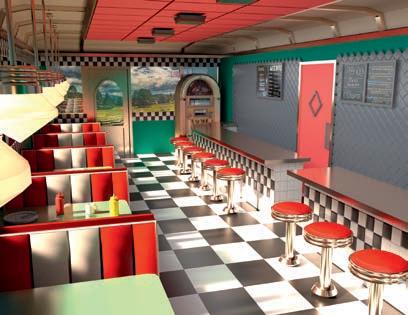
UPGRADE was founded by Josh Nadel ( DMD ’20) in 2016. However, after the onset of the COVID-19 pandemic in spring 2020, the club shut down. In fall 2021, two members resur rected the club: Edward Zhang ( DMD ’23, ENTI ’23) and Di Lu (DMD’22, CGGT’23).
“When we came back together in 2021, our goal for the group was not to make the best game, or even a good game, but to make a game,” shares Edward Zhang. “Our mission was to make a game within one school year and bring it to market, and we were able to achieve that.”
DMD students immerse themselves in the programming, mathematics and technologies that define contemporary computer graphics. Students produce work such as the pictured diner, created and rendered in Maya for Introduction to 3D Computer Modeling by then-student Saranya Sampath (DMD’21), now a Graphics Engineer at Unity Technologies. Also pictured is a screenshot from Animancer, an action-RPG video game that Josh Nadel (DMD’20), current Game Designer for Blizzard Entertainment, developed during his time as a member of UPGRADE
The game, Bionic Traveler , is a top-down, action RPG game that’s available to play on Steam. UPGRADE members took inspiration from the classic fantasy game The Legend of Zelda, and their game features a battle arena where players can combat enemies, an art museum that displays the original artwork created by UPGRADE’s art team, and a story log to showcase the narrative work from the writing team.
To build their games within the academic year, UPGRADE follows a hackathon-like struc ture, where students work in teams to complete miniature projects and then work to bring those mini games together into a collection. In previous years, UPGRADE had focused on creating a single project within distinct disciplinary teams, “When we came back together in 2021, our goal for the group was not to make the best game, or even a good game, but to make a game.”
EDWARD ZHANGsuch as programming, art, story, etc.; however, members found that it was difficult to interface with the different teams and development was slow. Now, having switched to the hackathon-like model for the 2022–2023 academic year, the group has plans to develop multiple games. To accelerate the development process, UPGRADE members use Unity, a free cross-platform game engine. Since its launch in 2005, Unity has been essential in ushering in the current era of acces sible game development that makes clubs like UPGRADE possible.
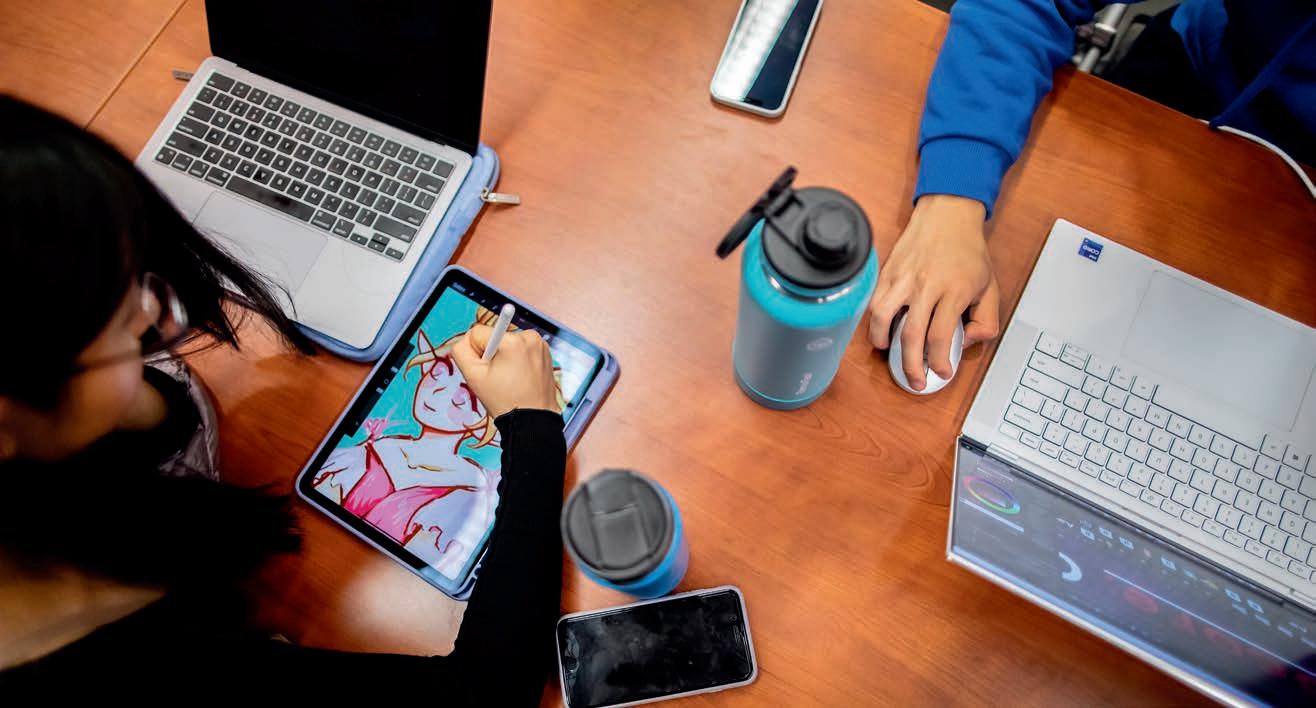
With greater access to game-development technologies outside of the classroom, what compels current students to pursue an engi neering degree? Students and alumni report that Penn Engineering’s emphasis on rigorous technical training prepares them to meet expec tations in the game industry. While access to coding education and game engines is increasing, excellence in gaming is shifting from sheer programming brawn to a multifaceted ability to bring all sides of a game together.
“You need a deep understanding of the tech nical side of game development to make big strides, and that is where Penn comes into play,” Levy concludes. “But it is also about how you can work as a team. You are building something unique and fresh that brings together a variety of perspectives. It takes a lot of soft skills, things they don’t always teach you in a textbook. In the game world, collaboration is crucial.”
GACHA
The UPGRADE Gacha was the UPGRADE 2022–23 training period project To complete it, 12 teams each created a character like the one pictured above and those on the preceding pages, along with an associated minigame; these were then merged into the code base written by the UPGRADE board.
This project was designed to introduce new recruits to Unity, Git collaboration and the basic game development pipeline
CAMERA ROLL
STUDIOS @ VENTURE LABS
the studios @ venture labs, a collaboration between Penn Engineering and Wharton, are a collection of workspaces and labs located in Tangen Hall that allow Penn students interested in entrepreneurship and innovation to access digital and analog fabrication technologies in order to rapidly make their ideas a reality.
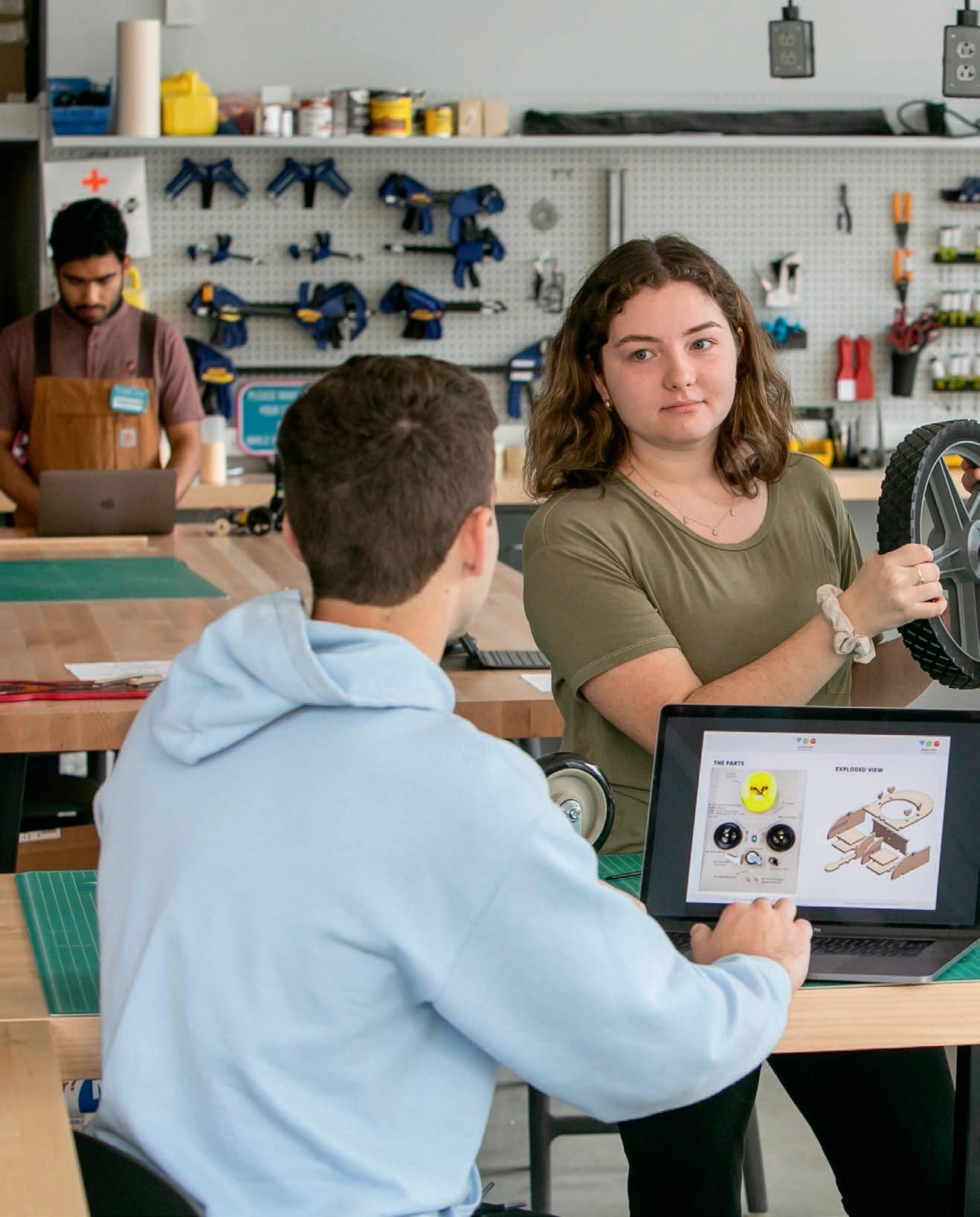
Alexa Chomat (IPD’24) created a beautiful laser-cut puzzle entitled Haetae for IPD/MEAM 4110: How to Make Things (a cornerstone course to the Studios’ mission) to connect with her grandmother, who speaks only Korean, while Alexa speaks only English. Each piece is etched with a question designed to facilitate meaningful conversation.
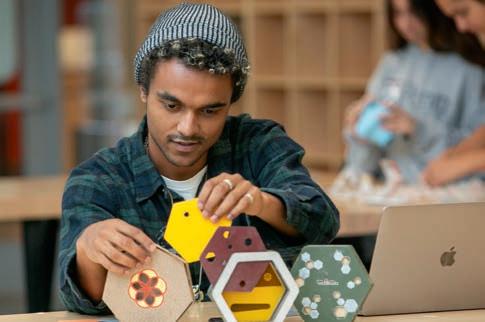
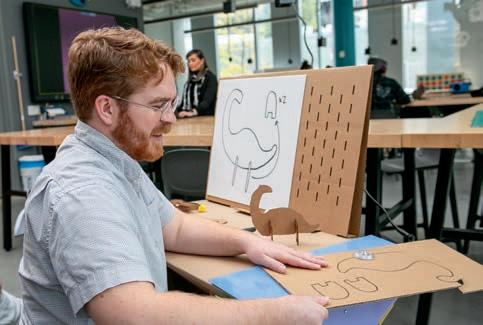
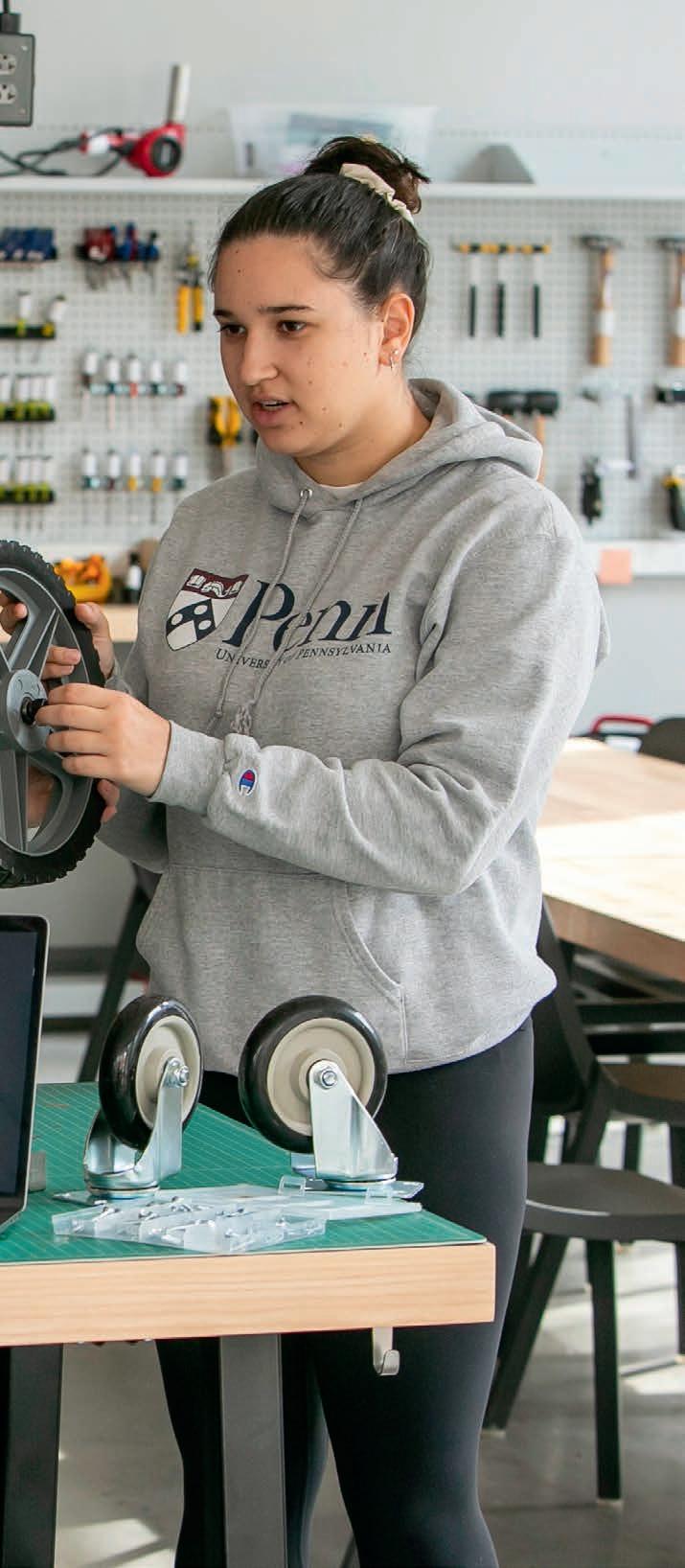
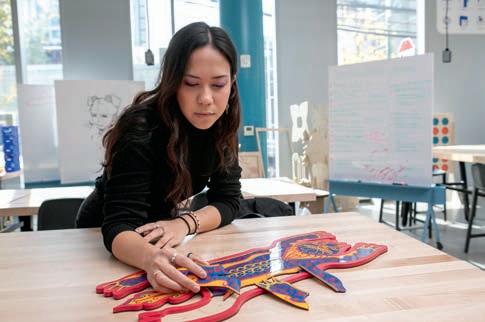
Penn Engineering Welcomes World’s Roboticists to Philadelphia
In may, penn engineering hosted the Institute of Electrical and Electronics Engineers (IEEE) International Conference on Robotics and Automation (ICRA) at the Pennovation Center and the Pennsylvania Convention Center. One of the world’s major robotics conferences, ICRA brought roughly 4,500 guests from 89 countries to the city, in addi tion to virtual attendees, as the conference marked its first in-person event since 2019. The five-day events included academic talks, workshops, the robotics expo and contests, as well as tours on Penn’s campus, including the Pennovation Center, the Singh Center for Nanotechnology and Penn Medicine.
Penn Electric Racing Unveils New REV7 Racecar Despite Pandemic Setbacks
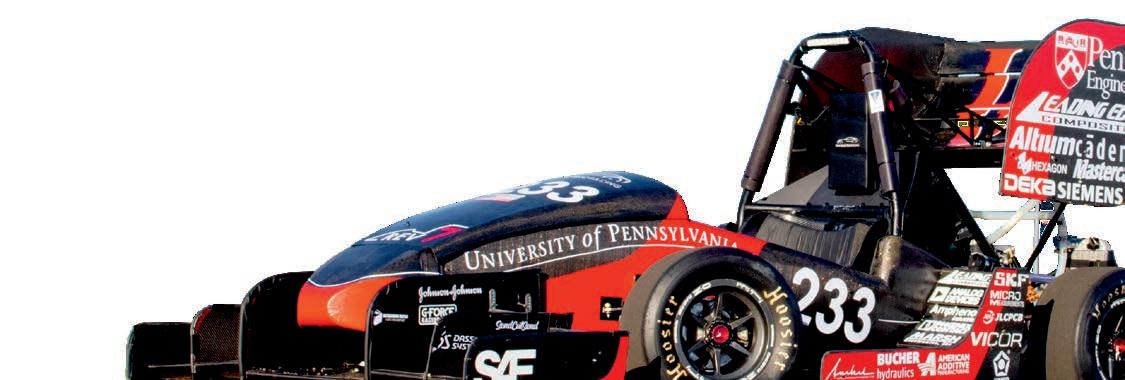
Penn Engineering Announces Online Master’s in Data Science
Penn engineering has introduced its second online master’s degree: the Master of Science in Engineering in Data Science ( program combines Penn Engineering’s Ivy League-quality coursework in topics such as big data, artificial intelligence and machine learning to students interested in pursuing careers ranging from data scientists to data engineers. Classes begin in January 2023.
After a two-year hiatus, Penn Electric Racing, Penn’s Formula Society of Automotive Engineers (FSAE) racecar-building team, unveiled their latest creation: the REV7. When Penn’s campus physically shut down due to the COVID-19 pandemic, the team was sent home before they were able to complete their previous REV6 model. During the ensuing time, when protocols meant working and studying from home, many of the team’s members ended up graduating, so the group elected to spend that time designing a new car. Key changes to the design include the switch from REV6’s fourwheel drive to REV7’s two-wheel drive, and the implementation of the team’s first pullrod suspension system. They also made the critical decision to change this design to rear-wheel drive, meaning that the team needed to redesign the battery pack and the powertrain, a composite of parts responsible for using energy stored in the vehicle’s battery system to make the car go.
Tangen Hall: A Headquarters for Innovation and Entrepreneurship
Located on the northeast corner of 40th and Sansom streets, Tangen Hall is referred to as the physical “start here button” for aspiring Penn entrepreneurs and innovators, with a mission of democratizing entre preneurship for all students. A partnership with the Wharton School, Penn Engineering and the Stuart Weitzman School of Design, Tangen is now also the home of Studios @ Venture Labs, a collection of workspaces and labs that house digital and analog fabrication technologies that empower the Penn community to make their ideas a reality.
CENTER is Part of a New NIH Education Initiative on Scientific Rigor
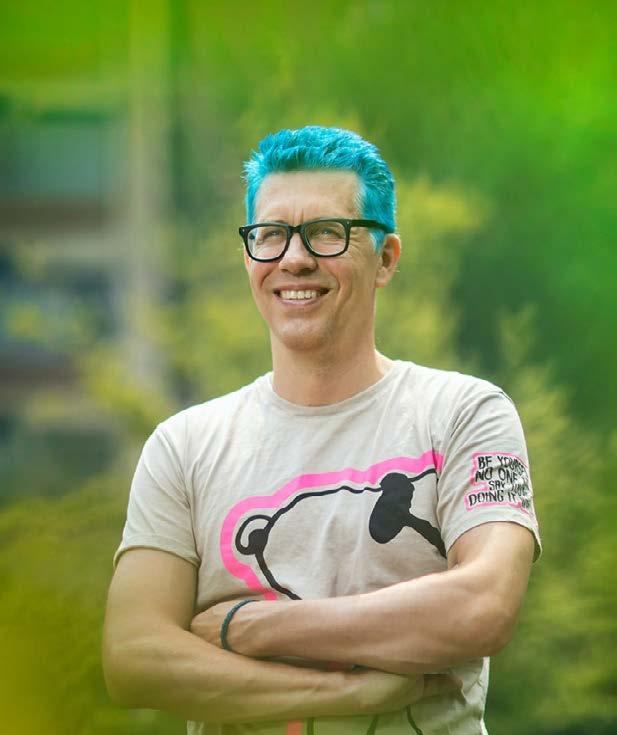
In order to combat the “replication crisis” in biomedical research the fact that a large percentage of experiments would not return the same results if they were conducted again the National Institute of Neurological Disorders and Stroke (NINDS), part of the National Institutes of Health (NIH), has launched the Initiative to Improve Education in the Principles of Rigorous Research. Konrad Kording, Nathan Francis Mossell University Professor with appointments in the Departments of Bioengineering and Computer and Information Science in Penn Engineering and the Department of Neuroscience in Penn’s Perelman School of Medicine, has been awarded one of the initia tive’s first five grants for “Creating an Educational Nexus for Training in Experimental Rigor,” or CENTER. This funding will support Kording and collaborators as they develop a user-friendly, open-source educational platform of modules that address biases in research, logical fallacies around causality, hypothesis development, literature search design, identifying experimental variables, and reducing confounding variables in research.
$3M to Train the Next Generation of Scientists on Soft Materials, Machine Learning and Science Policy
The national science foundation’s Research Traineeship Program’s latest series of grants are funding university programs focused on artificial intelligence and quantum information science and engineering. Penn Engineering researchers and collaborators across the University, led by Chinedum Osuji, Eduardo D. Glandt Presidential Professor and Chair of Chemical and Biomolecular Engineering, have received $3 million for a new Penn project on Data Driven Soft Materials Research, which will be used to provide specialized training for 50 Ph.D. students and 40 master’s students, enabling them to advance soft materials research using data-intensive methods, and to use science policy to better understand the intersection of new soft-material technology with real-world problems.

NEW FACULTY
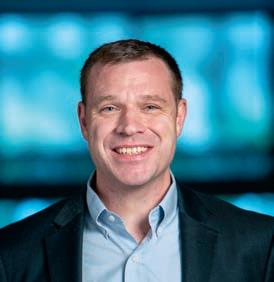
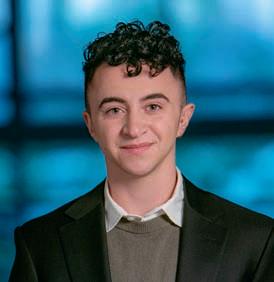
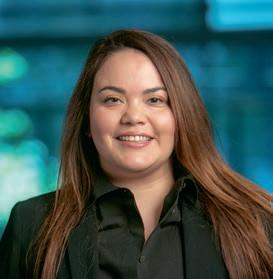
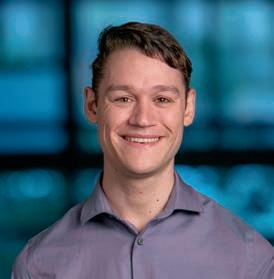
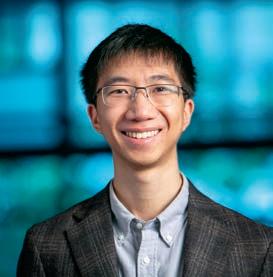
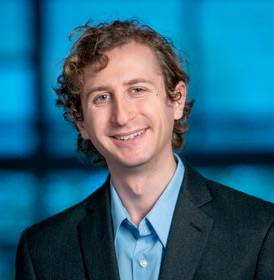
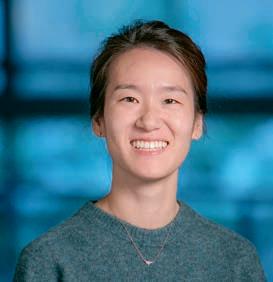
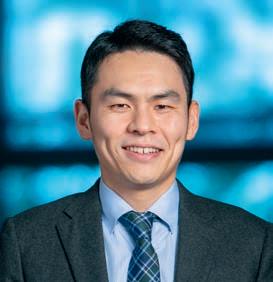
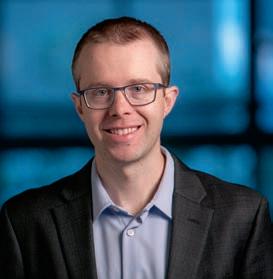
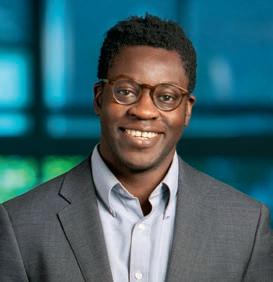 Kyle Vining Assistant Professor Preventive and Restorative Sciences Penn Dental Medicine Materials Science and Engineering Ph.D. in Bioengineering Harvard University D.D.S., University of Minnesota
Eric Wong Assistant Professor Computer and Information Science Ph.D. in Machine Learning Carnegie Mellon University
Gregory Bowman
Louis Heyman University Professor Bioengineering Biochemistry and Biophysics Perelman School of Medicine Ph.D. in Biophysics Stanford University
Andrew Head Assistant Professor Computer and Information Science Ph.D. in Computer Science University of California, Berkeley
Jina Ko Assistant Professor Bioengineering Pathology and Laboratory Medicine Perelman School of Medicine Ph.D. in Bioengineering University of Pennsylvania
Dohyung Kim Assistant Professor Chemical and Biomolecular Engineering Ph.D. in Materials Science and Engineering University of California, Berkeley
Christopher Madl Assistant Professor Materials Science and Engineering Ph.D. in Bioengineering Stanford University
Danaë Metaxa Raj and Neera Singh Term Assistant Professor Computer and Information Science Ph.D. in Computer Science Stanford University
Ottman A. Tertuliano AMA Family Assistant Professor Mechanical Engineering and Applied Mechanics Ph.D. in Materials Science California Institute of Technology
Kyle Vining Assistant Professor Preventive and Restorative Sciences Penn Dental Medicine Materials Science and Engineering Ph.D. in Bioengineering Harvard University D.D.S., University of Minnesota
Eric Wong Assistant Professor Computer and Information Science Ph.D. in Machine Learning Carnegie Mellon University
Gregory Bowman
Louis Heyman University Professor Bioengineering Biochemistry and Biophysics Perelman School of Medicine Ph.D. in Biophysics Stanford University
Andrew Head Assistant Professor Computer and Information Science Ph.D. in Computer Science University of California, Berkeley
Jina Ko Assistant Professor Bioengineering Pathology and Laboratory Medicine Perelman School of Medicine Ph.D. in Bioengineering University of Pennsylvania
Dohyung Kim Assistant Professor Chemical and Biomolecular Engineering Ph.D. in Materials Science and Engineering University of California, Berkeley
Christopher Madl Assistant Professor Materials Science and Engineering Ph.D. in Bioengineering Stanford University
Danaë Metaxa Raj and Neera Singh Term Assistant Professor Computer and Information Science Ph.D. in Computer Science Stanford University
Ottman A. Tertuliano AMA Family Assistant Professor Mechanical Engineering and Applied Mechanics Ph.D. in Materials Science California Institute of Technology
CEMB 2.0: Developing
‘Mechanointelligence’
The Center for Engineering Mechanobiology (CEMB) is one of 18 active NSF Science and Technology Centers, bringing together dozens of researchers from Penn Engineering and the Perelman School of Medicine, as well as others spread across campus and at partner institutions around the world to study the physical forces that govern the behavior of cells and their communication with their neighbors. With its funding renewed for another five years, CEMB is entering into a new phase of its mission, centered on the nascent concept of “mechanointelligence,” or attempting to understand the forces that allow cells to sense, remember and adapt to their environments. Ultimately, harnessing these forces would allow researchers to help multicellular organisms plants, animals and humans better adapt to their environments as well.
The dynamics governing mechanointelligence vary greatly along time- and length-scales, so detailed models of individual cells and their components are necessary to connect the effects of their physical environments to the downstream effects those forces have on biological processes.
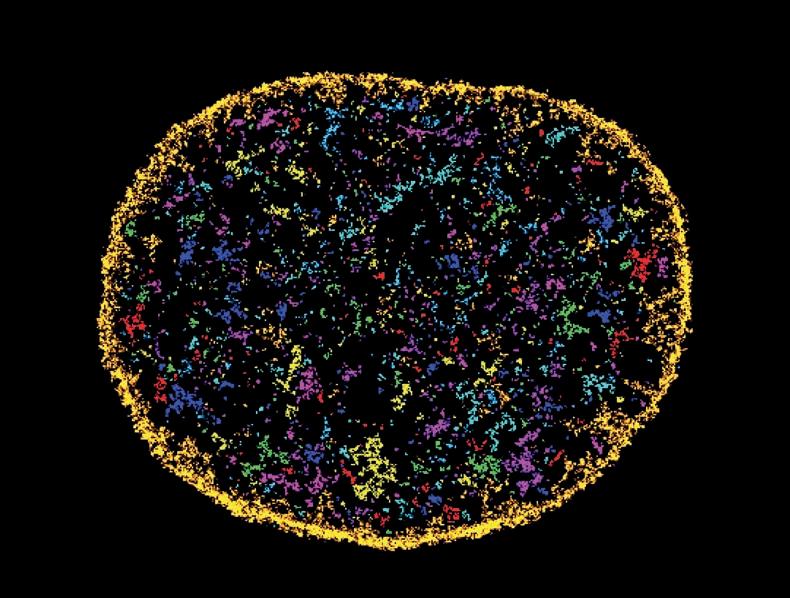
‘Curious Minds: The Power of Connection’
How does the tangle of neurons in our brains wire itself up to learn new things? Dani S. Bassett, J. Peter Skirkanich Professor in Bioengineering and Electrical and Systems Engineering and Director of the Complex Systems Lab, studies the relationship between the shape of the brain’s networks of neurons and its abilities, especially the way the shape of the network grows and changes with the addition of new knowledge. To get at the fundamentals of the question of curi osity, Bassett worked with their identical twin Perry Zurn, Associate Professor of Philosophy at American University, and the two have investigated the many different ways a person can exhibit curiosity, resulting in a new book on the subject, Curious Minds: The Power of Connection.
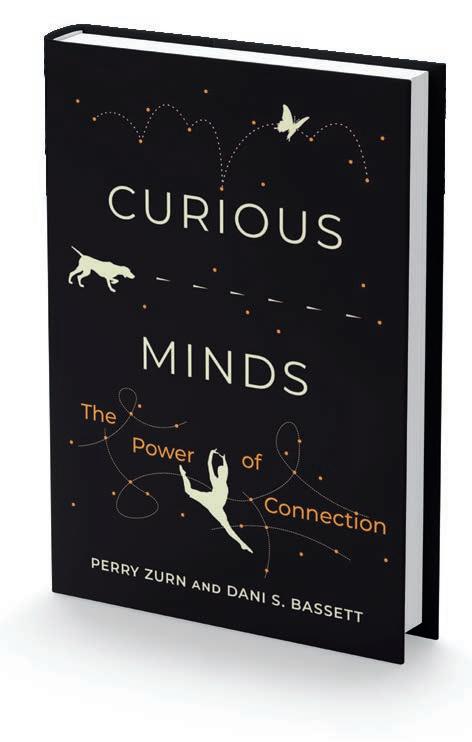
New ASSET Center Focuses on the Safety, Explainability and Trustworthiness of AI Systems

Penn engineering’s newly formed ASSET (AI-enabled Systems: Safety, Explainability and Trustworthiness) Center, part of Penn Engineering’s Innovation in Data Engineering and Science (IDEAS) initiative, aims to realize the full potential of AI-based decision making by designing it to be more reliable and transparent. The Center will focus on science and tools for enhancing AI-based systems so that developers can guarantee their reliable operation and users can trust them to meet their expectations.
A New Makerspace for Materials Students
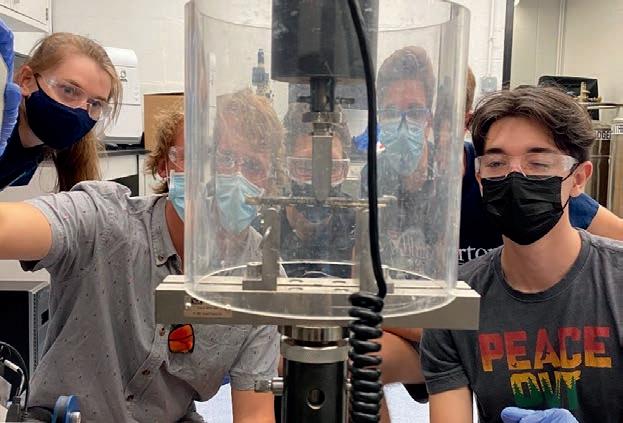
During the pandemic’s at-home period, a group of students in Materials Science and Engineering dreamed up a student-run space where they could apply their newfound knowledge to creative projects. After returning to campus, the group worked with departmental leadership and staff to turn their proposed MatSci Makerspace into a reality. The design, fabrication and testing done in the MatSci Makerspace deepens students’ knowledge on the synthesis, processing, structure, properties and application of materials. It also fosters teamwork and communication, which is essential in an ever-more complex ecosystem.
Introducing Scholarships for MCIT Online
In order to deepen Penn Engineering Online’s commitment to diversity and accessibility, the program has expanded the School’s on-campus diversity scholarship program to include MCIT Online students. Starting with the Fall 2022 cohort, incoming MCIT Online students are now eligible to apply for the Dean’s Master’s Scholarship, which is designed to increase the program’s impact and expand the diversity of voices and experiences its students bring to the classroom.
Max Mintz was a wonderful advisor and educator. His love for learning translated into a love for teaching. He was a constant reminder of why I came to Penn: to learn from passionate people like him.
CHELSEA PAN CIS’24Engineering school pushed me to the very limits of my abilities and sometimes beyond them, but Max Mintz always encouraged and supported me. There were times when I considered walking away from it all, and I might have if he had not assured me to not worry about a few failed midterms here and there. He was always excited about what I was doing and supported my vision for future work in the environmental field. He had a great passion to help people succeed.
PETER KARASIK SSE’79
Max Mintz had such tremendous energy during lectures and would always aggressively write out his thinking on the whiteboard. He would, of course, run out of space and be forced to start erasing things, much to the chagrin of many students. He would tell us, “Don’t worry, everything is stored on the eraser so we should be able to get it back!”
EYTAN SEIDMAN CIS’01Max Mintz saw my potential and believed in and supported me, despite that I wasn’t particularly excelling through the CIS curriculum at Penn. He helped to keep me in STEM when I was on the edge of switching out.
KIMBERLY KREIDERDMD’18
Remembering Max Mintz
Max m intz, p rofessor in the d epartment of Computer and Information Science, passed away on April 18, 2022, at the age of 79.
Dr. Mintz earned bachelor’s and master’s degrees in Electrical Engineering and a Ph.D. in Systems Theory, all from Cornell University. He joined Penn in 1974 as an Assistant Professor in Systems Engineering, now part of the Department of Electrical and Systems Engineering. He later changed his primary department to Computer and Information Science (CIS) in 1986, and he was an inte gral part of CIS undergraduate education and advising for 36 years.
Dr. Mintz was a legendary teacher and an extraor dinary advisor to hundreds of computer scientists. He was able to inspire his students to go well beyond their comfort level in their academic preparation and studies, for which he won numerous awards in recog nition of his work as an educator, including the S. Reid Warren, Jr. Award, the University’s Lindback Award for
Distinguished Teaching, and the Ford Motor Company Award for Faculty Advising. He was also a member of the GRASP Lab, where his research interests incorporated control theory and decision-making under uncertainty.
Dr. Mintz’s students described him as being “funny, animated, exciting, clear, passionate and dedicated,” and many can recount the long list of “Maxisms” that he would deliver throughout his years of teaching. One student noted, “He genuinely cared for students and would do anything necessary to help them succeed.” Even while ill, he continued working on his textbook for his Freshman Seminar course, CIS 181: The Quantum and the Computer, which he was planning to publish as a book for the Society for Industrial and Applied Mathematics.
Dr. Mintz was a friend, colleague and mentor to so many Penn Engineers. Anyone who knew him could recognize him from a block away due to his trademark yellow windbreaker, and he was always ready with a smile, whether for a colleague, a student in his class or a staff member he’d known for years.
Dr. Mintz is survived by his wife, Catherine Mintz.
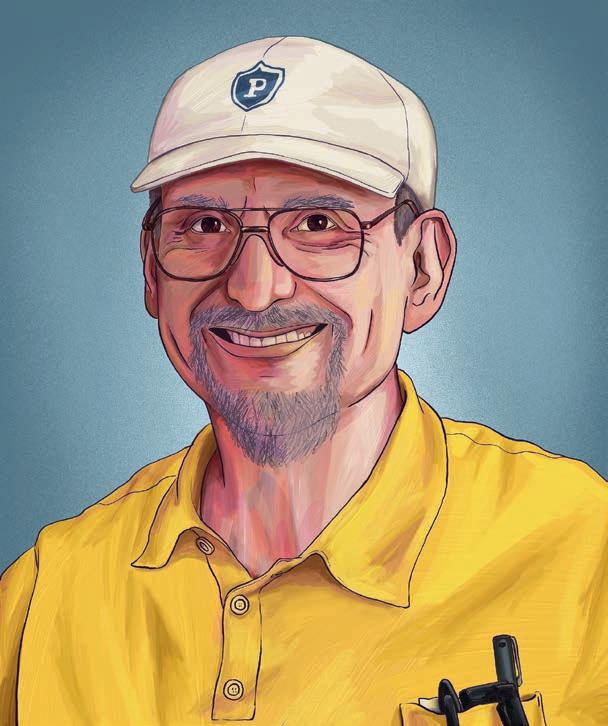
WHY I GIVE
(BE’ 2001)
HONOR ROLL
Download the 2022 Honor Roll and learn more about the ways that you can give back to Penn Engineering.
Dr. michelle lubetzky graduated from Penn in 2001 with a bachelor’s in Bioengineering. After completing her degree, she went on to medical school at Albert Einstein College of Medicine of Yeshiva University and completed both a residency and a fellow ship in Nephrology and Transplantation at New York Presbyterian Weill Cornell Medical Center. Dr. Lubetzky is currently a practicing physi cian and an Associate Professor of Medicine in the Division of Nephrology at Dell Seton Medical Center at the University of Texas. As a clinician and researcher for over 10 years, she has focused on genetics as a tool for diagnosis of kidney disease and kidney transplantation outcomes, authoring more than 40 peer-reviewed articles.
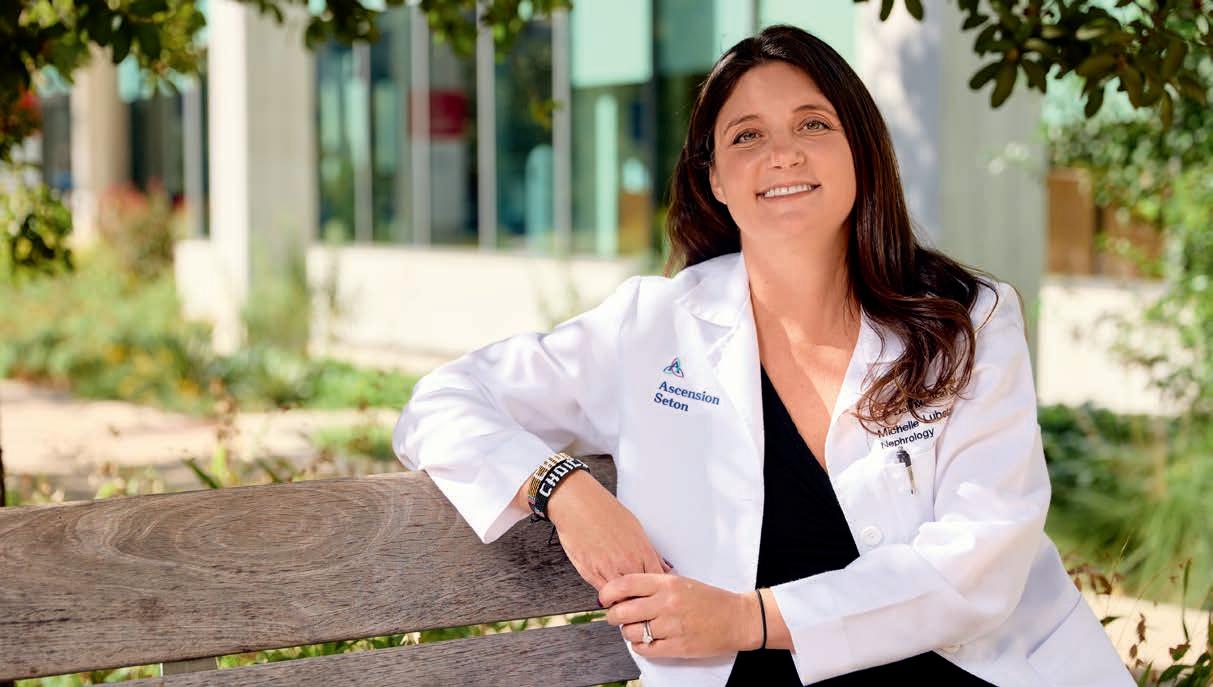
Why did you choose to attend Penn Engineering? I always loved math and science, and I knew I wanted to pursue engineering because it’s such a great foundation. I was interested in medicine, and I knew that bioengineering would put me in an ideal position for either the technical side of medicine or something clinical. I visited Penn and fell in love. The students I saw were bright and enthusiastic about not only their studies but also sports, clubs and other activities. It just felt like the right mix for me.
How did your time at Penn contribute to your success as a clinician and researcher?
Engineering teaches you to understand concepts, systems and the way that you need to think through problems. I gravitated toward kidney disease during medical school because it wasn’t just memorizing information, it was about under standing the physiology of how the body works. Learning how kidneys filter proteins and electro lytes was just like solving a math or engineering problem, and it was a really smooth transition. Additionally, now that a huge part of medical research includes bioinformatics, I have found that my engineering degree prepared me to speak that language as well.
Why is it important to you to give back to Penn Engineering?
I feel very grateful for the opportunities my education at Penn Engineering has given to me.
My family did not have a lot of money when I was growing up, and because of other people who donated, Penn was able to give me essentially an equal aid package to what my home state school would have covered. I feel fortunate to be part of the Penn community, and it was very important to me when thinking about how to give back to do it in the form of a scholarship for others with financial need.
Why is Annual Giving meaningful?
If someone has a limited amount to give, it’s still a way to give back that is more impactful than people realize. I’ve tried to give what I could to Annual Giving every year since I was in the posi tion to do so. It gives the School opportunities and the flexibility to help current students and respond to changing priorities. Each individual gift combines to allow Penn to stay at the fore front of higher education.
 Michelle Lieberman Lubetzky
Michelle Lieberman Lubetzky
Penn Engineering Board of Advisors
Mr. Robert M. Stavis, EAS’84, W’84
Board Chair Partner
Bessemer Venture Partners Larchmont, NY
Mr. Andrew Africk, L’92, WG’92 CEO Searay Capital LLC New York, NY
Mr. Peter Armstrong, ENG’87 Private Investor Westport, CT
The Honorable Harold Berger, EE’48, L’51
Managing Partner Berger and Montague, P.C. Philadelphia, PA
Mr. Dennis “Chip” Brady, C’94, W’94 Partner
LSN Partners, LLC Gladwyne, PA
Mr. Jonathan Brassington, GEng’97 Executive VP, Digital Customer Experience Capgemini Group Wayne, PA
Mr. Ric Calvillo, C’90 Chairman Zeenk Boston, MA
Mr. Peter N. Detkin, Esq., EE’82, L’85 Managing Director Sherpa Technology Group Founder, Intellectual Ventures Palo Alto, CA
Mr. Goodwin Gaw, ENG’91, W’91 Founder and Managing Principal Gaw Capital Partners Hong Kong
Ms. Pooja Goyal, ENG’02, W’02
Partner and Chief Investment Officer Carlyle Global Infrastructure New York, NY
Mr. Alex Haidas, C’93, ENG’93, WG’98
Founder and Managing Director Bluewall Capital Ltd. London, UK
Ms. Sarah Wolf Hallac, EE’86, W’86 Consultant BlackRock New York, NY
Mr. Lloyd W. Howell, Jr., EE’88 Executive VP, CFO, and Treasurer Booz Allen Hamilton, Inc. Washington, DC
Mr. Alex T. Krueger, ENG’96, W’96 President and CEO First Reserve International, Ltd. Greenwich, CT
Dr. John F. Lehman, Jr., GR’74
Chairman and Founding Partner J.F. Lehman & Company New York, NY
Mr. Ryan D. Limaye, ENG’93, W’93, WG’93 Managing Director, Co-Head, Global Technology Investment Banking Goldman Sachs Group, Inc. Wayne, PA
Mr. Rajeev Misra, ME’85, GEN’86 Head of Strategic Finance Softbank Group London, UK
Mr. Ofer Nemirovsky, EE’79, W’79 Head, Vomisa LLC Senior Advisor, HarbourVest Partners, LLC Boston, MA
Ms. Alison Newman, C’83 Partner Fox Rothschild, LLP New York, NY
Mr. Mitchell I. Quain, EE’73 Board Chair Emeritus Senior Advisor Carlyle Group New York, NY
Mr. Andrew S. Rachleff, W’80 Board Chair Emeritus Executive Chairman Wealthfront, Inc. Redwood City, CA
Mr. Allie P. Rogers, ENG’87, W’87 Chief Operating Officer Trendalytics Innovation Labs, Inc. New York, NY
Dr. Jeffrey M. Rosenbluth, ENG’84 Private Investor Sands Point, NY
Mr. Theodore E. Schlein, C’86 General Partner
Kleiner Perkins Caufield & Byers Menlo Park, CA
Dr. Krishna P. Singh, MS’69, PhD’72 President and CEO Holtec International Marlton, NJ
Dr. Rajendra Singh Chairman and CEO Telcom Ventures LLC Alexandria, VA
Ms. Juliet Sjöborg, EE’85, WG’92 Director Plena Capital Ltd. London, UK
Mr. Harlan M. Stone, C’80 President and CEO HMTX Industries LLC Norwalk, CT
Mr. Philip Trahanas, GEE’96, WG’96 Private Investor Fairfield, CT
Mr. Frederick J. Warren, ME’60, WG’61 Founder Sage Venture Partners, LLC Winter Park, FL
Mr. Jonathan Z. Wilf, ENG’06 Partner Garden Homes Short Hills, NJ
The University of Pennsylvania values diversity and seeks talented students, faculty and staff from diverse backgrounds. The University of Pennsylvania does not discriminate on the basis of race, color, sex, sexual orientation, gender identity, religion, creed, national or ethnic origin, citizenship status, age, disability, veteran status or any other legally protected class status in the administration of its admissions, financial aid, educational or athletic programs, or other University-administered programs or in its employment practices. Questions or complaints regarding this policy should be directed to the Executive Director of the Office of Affirmative Action and Equal Opportunity Programs, Suite 421 Franklin Building, 3451 Walnut Street, Philadelphia, PA 19104-6205; or (215) 898-6993 (Voice).
Non Profit Org. U.S. Postage PAID
Permit No. 2563 Philadelphia, PA
School of Engineering and Applied Science University of Pennsylvania
123 Towne Building I 220 South 33rd Street Philadelphia, PA 19104-6391
www.seas.upenn.edu
Data as Art
Located at the northeast corner of 34th and Chestnut Streets, the forthcoming Amy Gutmann Hall will serve as the hub for Penn Engineering’s IDEAS Initiative, a wide-ranging investment in data science.
The University has awarded polymedia artist Eto Otitigbe a commission to create Cascode, a landmark public art installation that embodies this initiative. Measuring approximately 60 feet high, Cascode will be installed on the facade of the building adjacent to Amy Gutmann Hall, slated for completion in 2024.

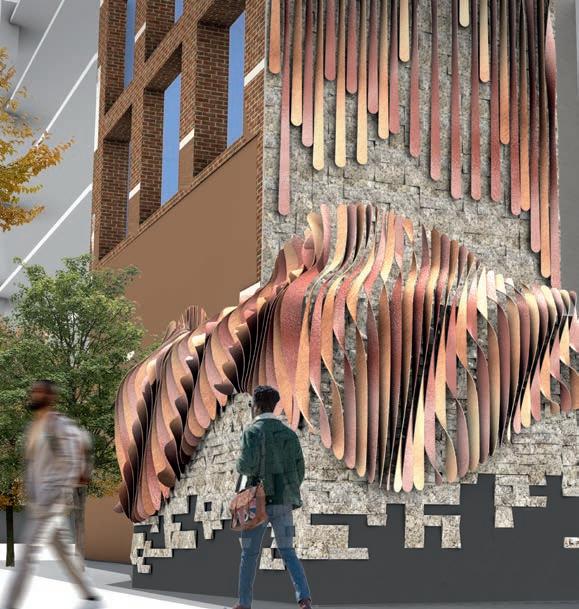
As part of the Philadelphia Housing Development Corporation’s Percent for Art program, Cascode will encompass a mix of organic forms, natural materials and datainformed design to represent the intersection of environment, health, community and data, and its collective impact on West Philadelphia residents.
The piece will utilize three main materials: natural stones and metals in earth tones that play well in natural light, paired with LED lighting that lends itself to nighttime activation. A large part of the Cascode project’s design includes an online component in which a wide range of West Philadelphia and Penn stakeholders will have the opportunity to respond to engaging prompts that provide data, which will in turn be used to inform Cascode’s final form.
CASCODE